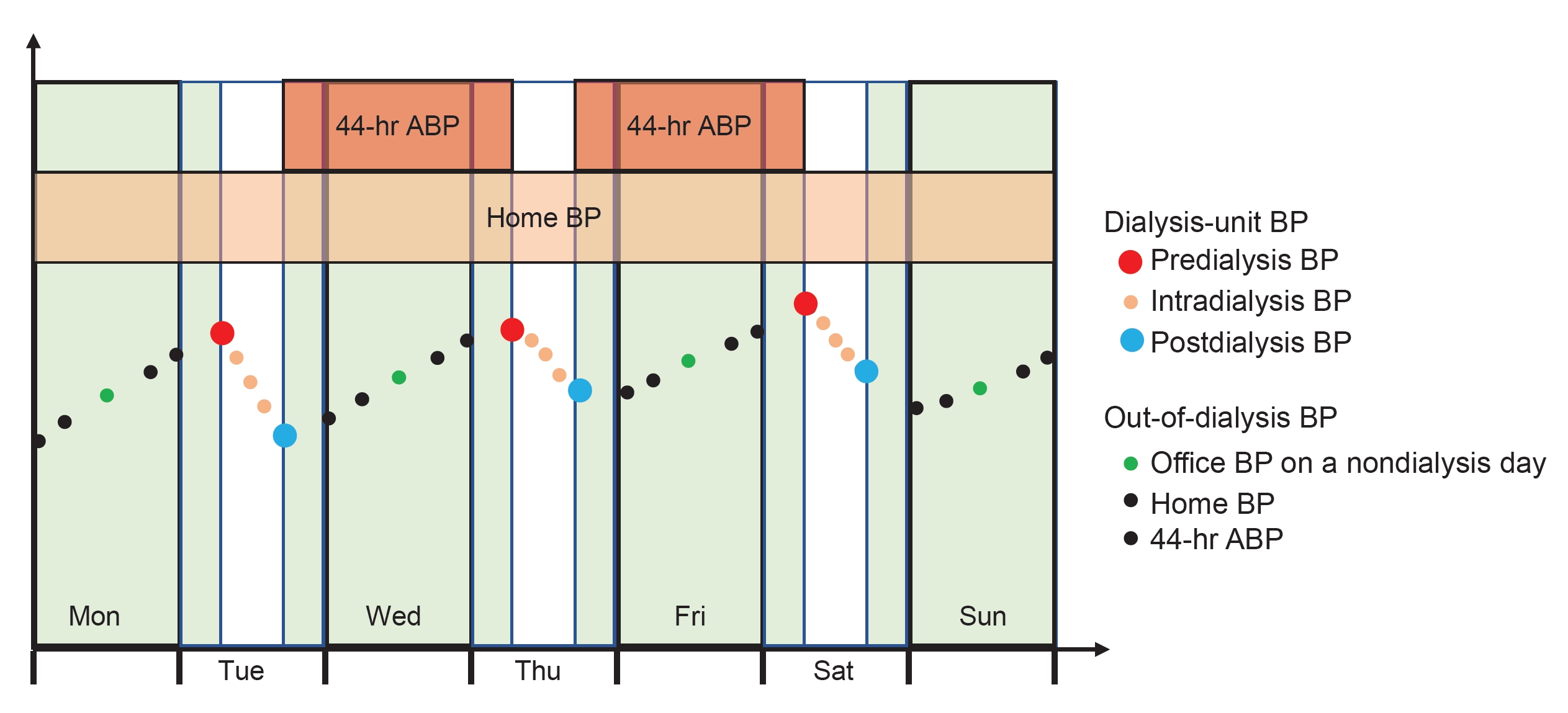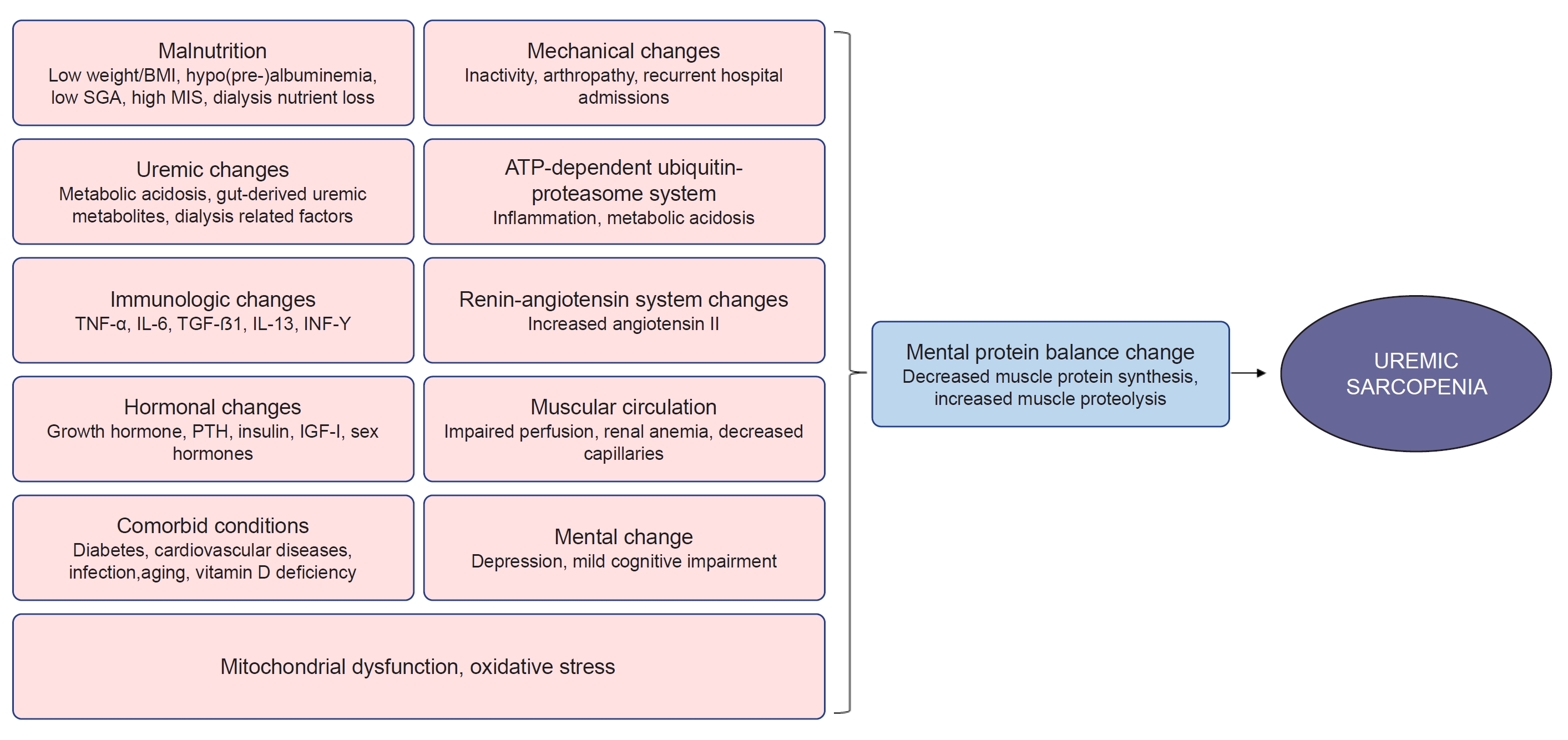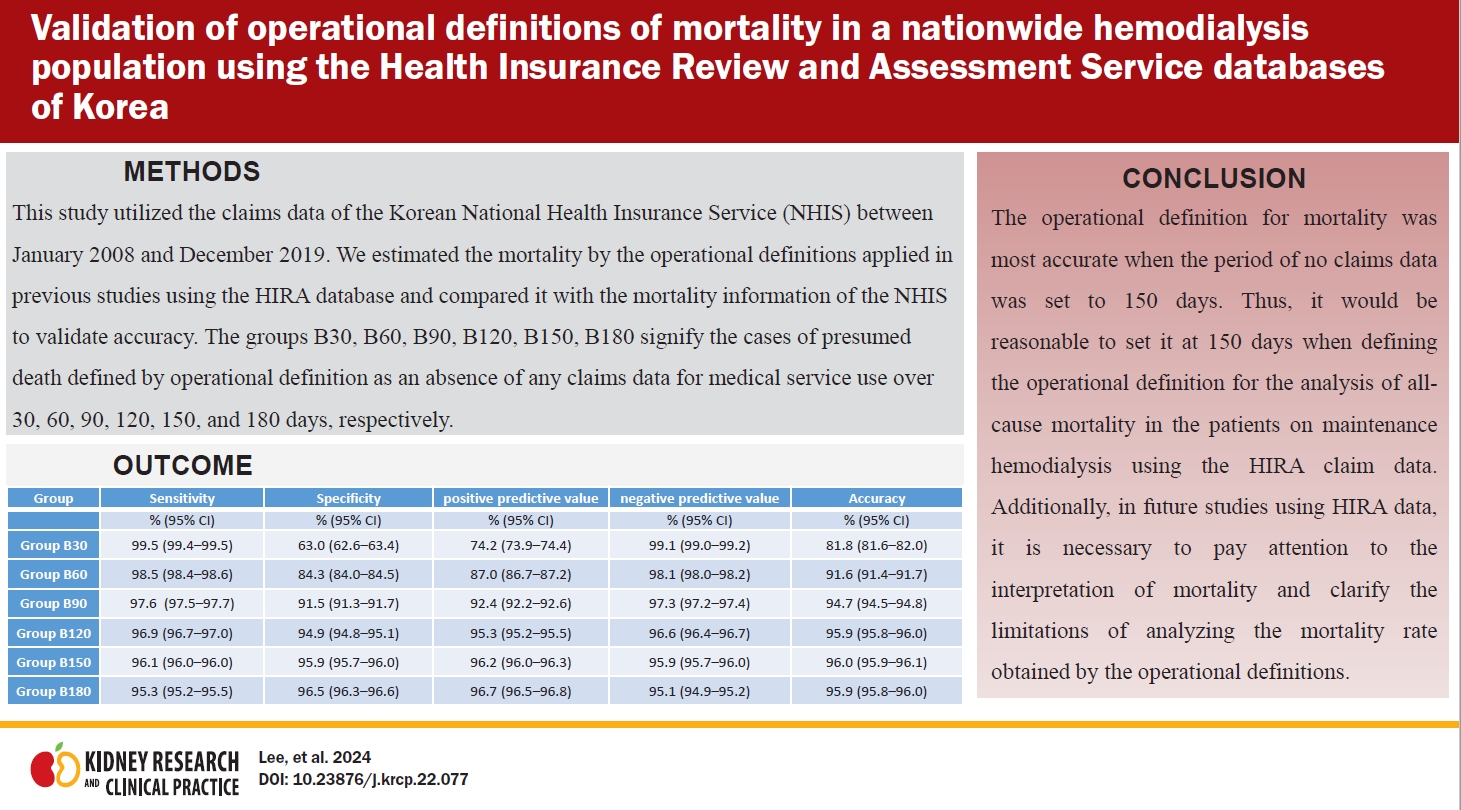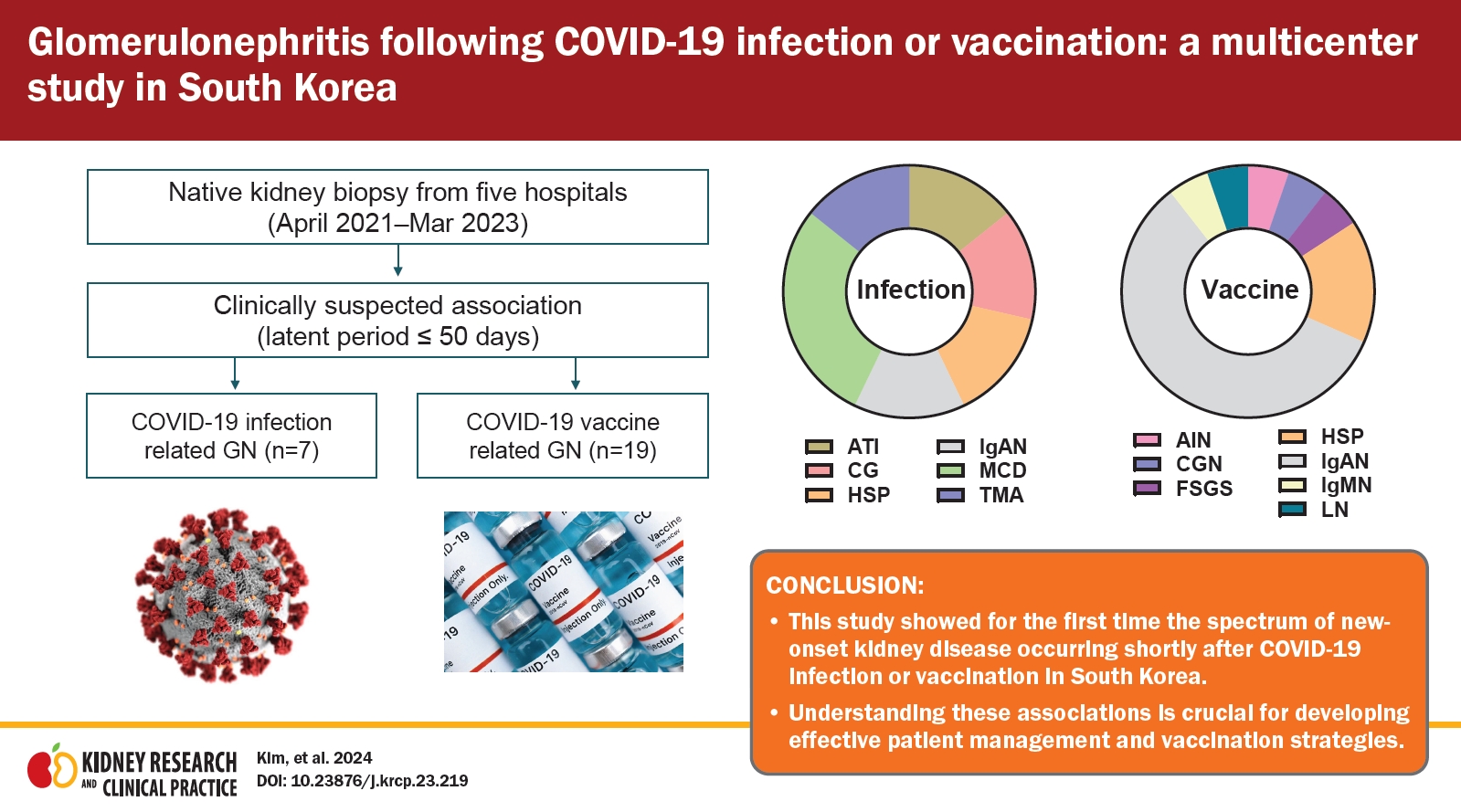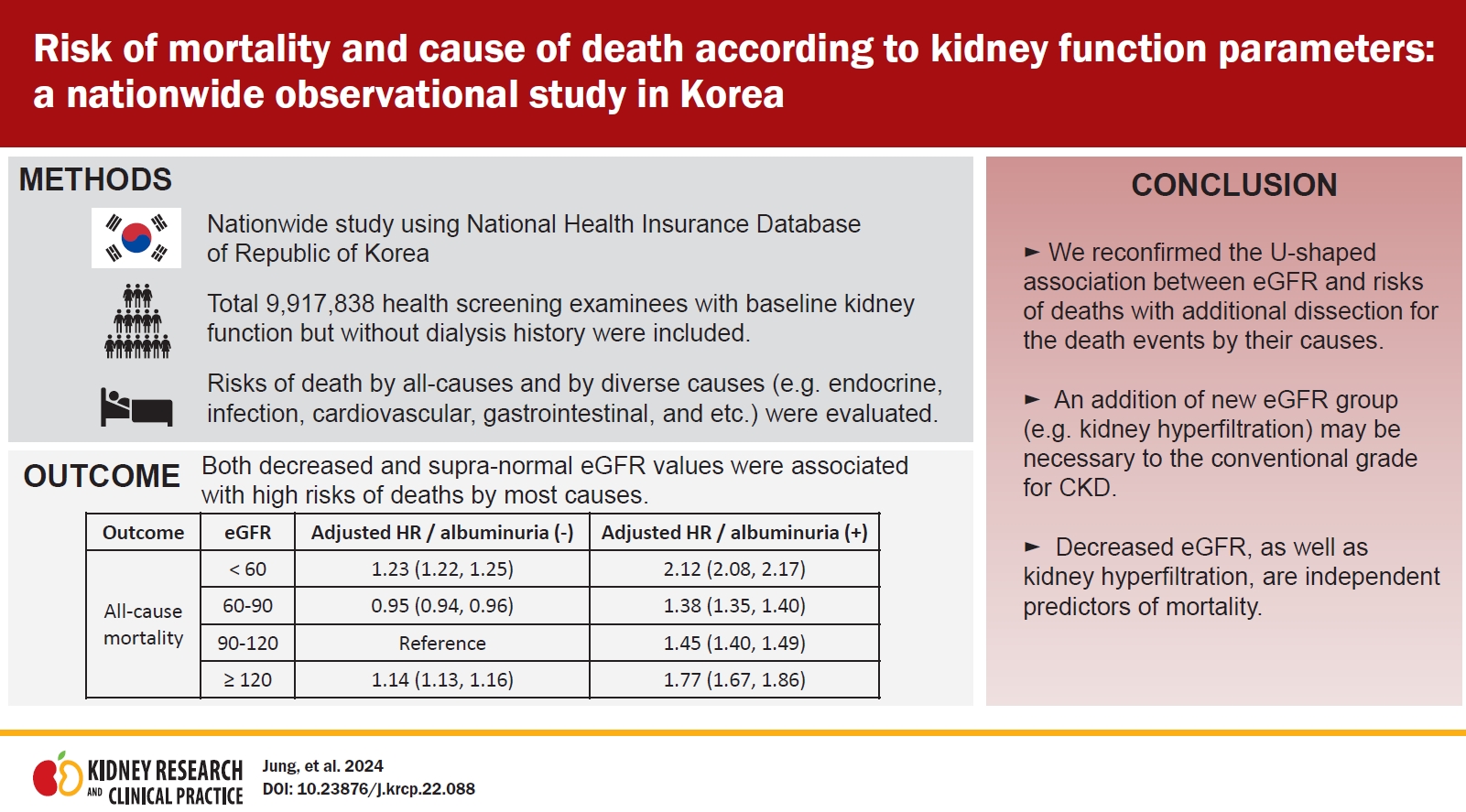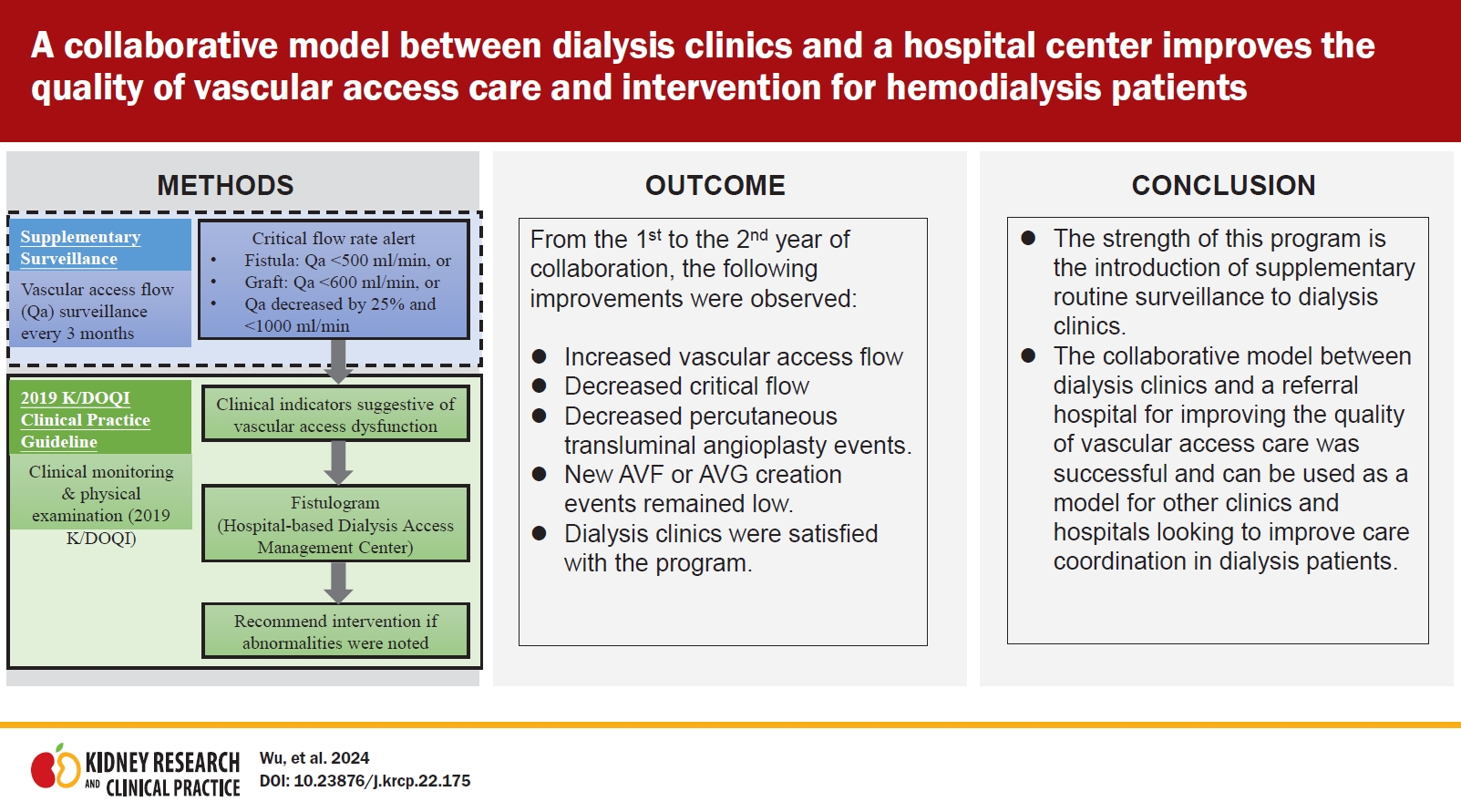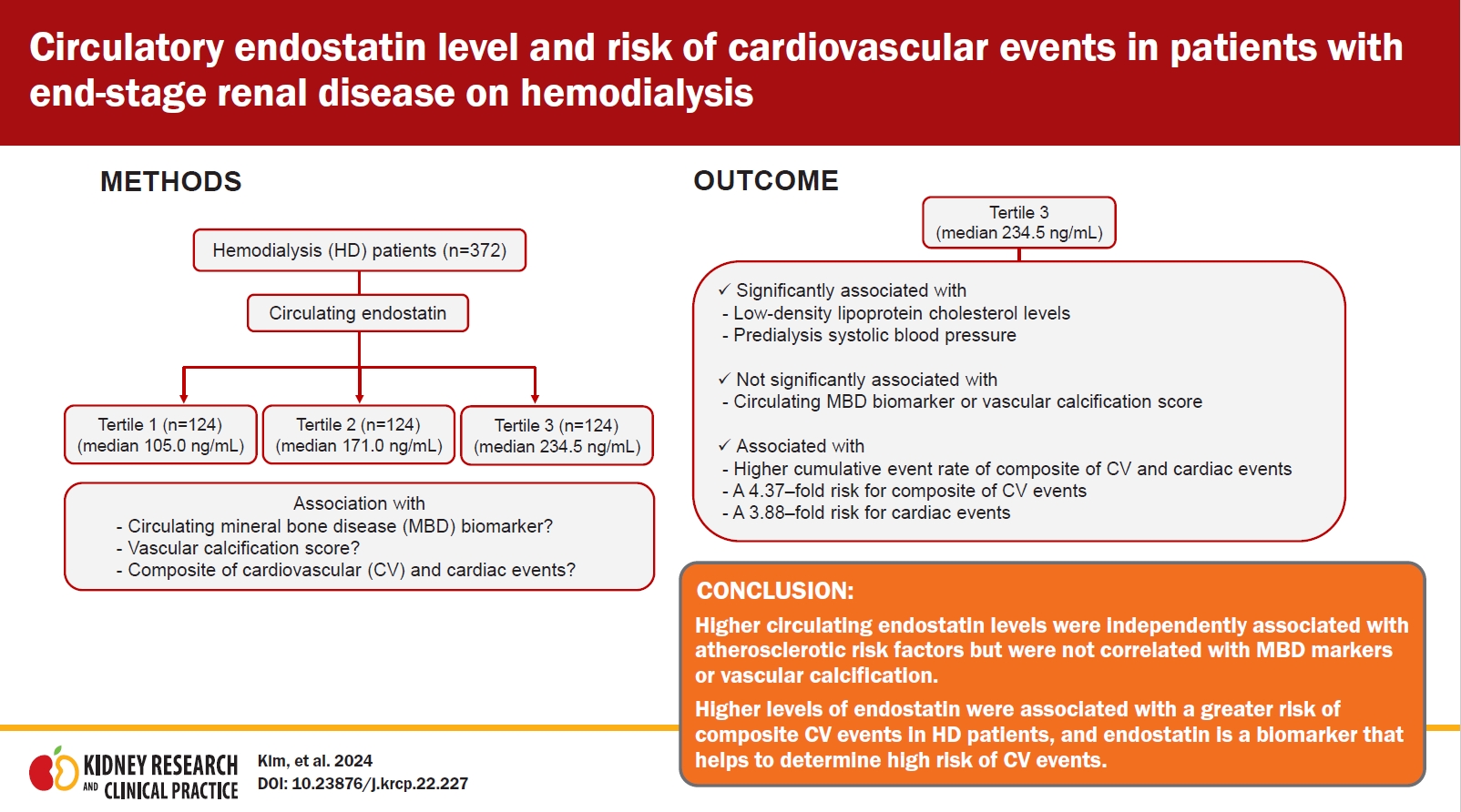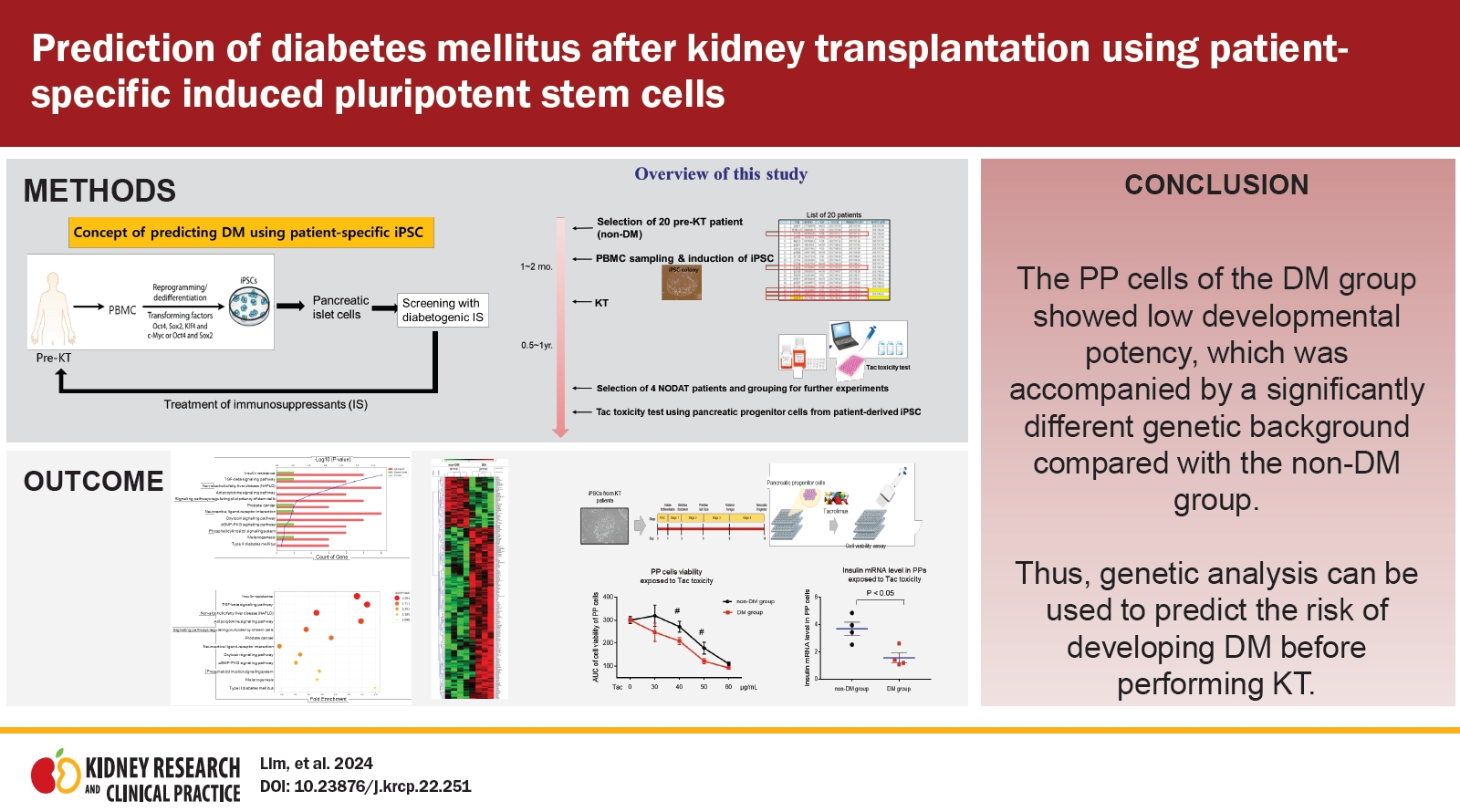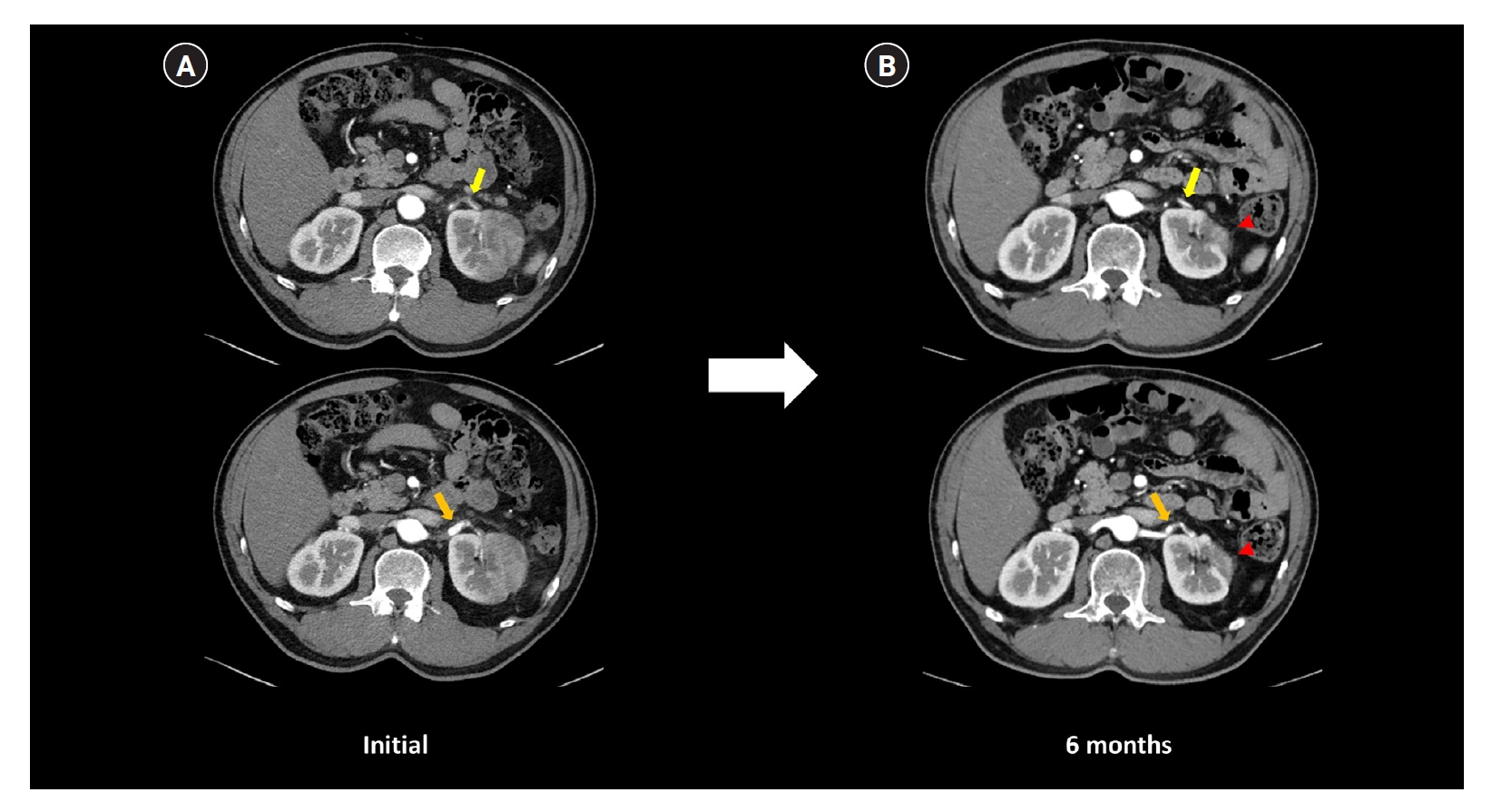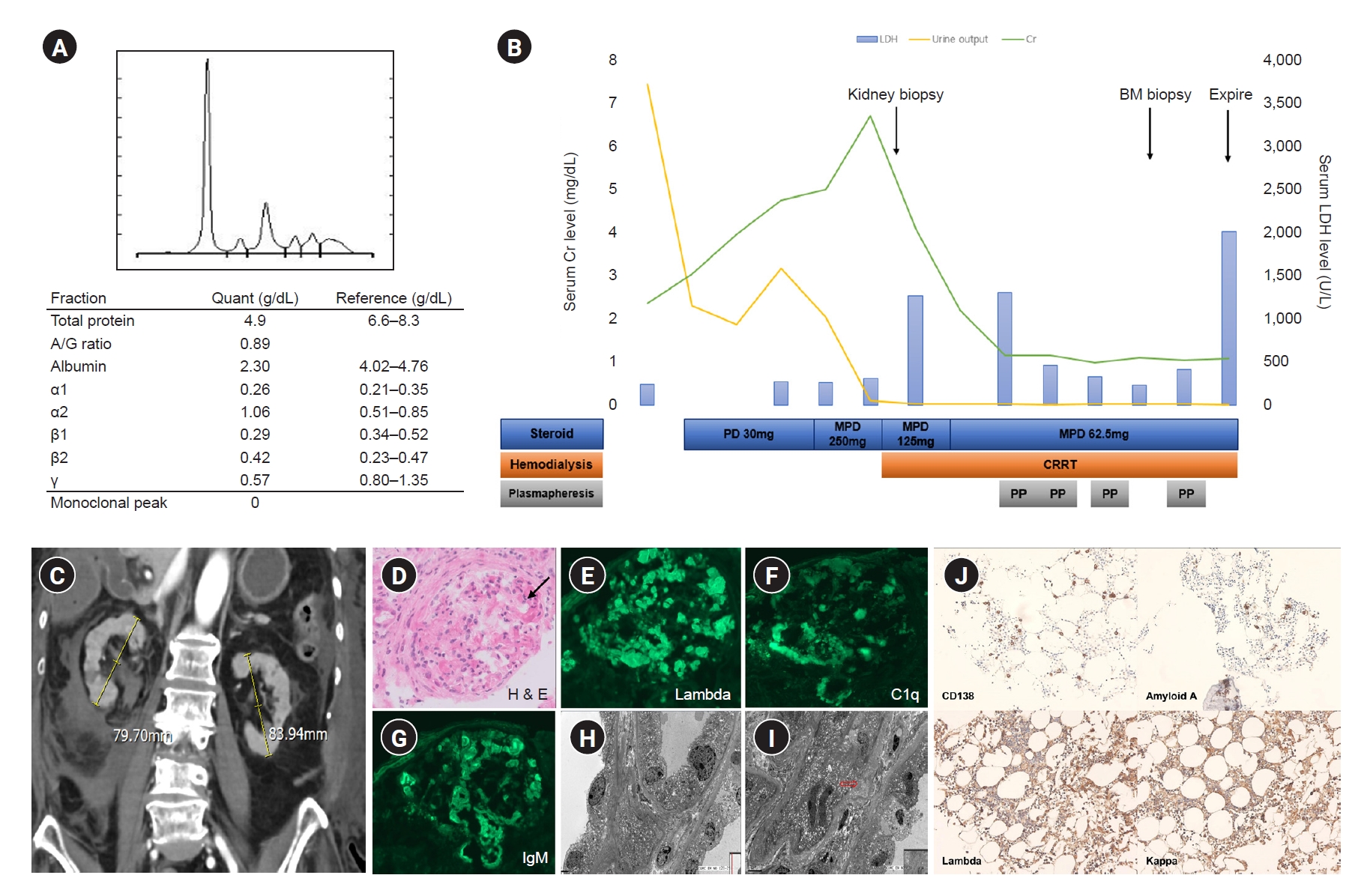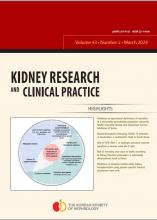-
Editorial
February 19, 2024
- On operational definitions of mortality
- Hakmook Kang
- Kidney Res Clin Pract. 2024;43(2):131-132.
- Special Article
- Asymptomatic hematuria in children: Korean Society of Pediatric Nephrology recommendations for diagnosis and management
- Eujin Park, Sang Woon Kim, Su Jin Kim, Minki Baek, Yo Han Ahn, Eun Mi Yang, Myung Hyun Cho, Hyun Kyung Lee, Kyoung Hee Han, Yae Lim Kim, Miyoung Choi, Hee Gyung Kang, Jin-Soon Suh
- Received September 1, 2023 Accepted November 12, 2023
-
Hematuria is a relatively common condition among school-aged children. Because international guidelines for asymptomatic hematuria in children are unavailable, developing practical guidelines for the diagnosis and management of asymptomatic hematuria based on scientific evidence while considering real-world practice settings, values, and patient and physician preferences is essential. The Korean Society of Pediatric Nephrology developed clinical guidelines to address key questions... -
DOI: https://doi.org/10.23876/j.krcp.23.231 [Epub ahead of print]
- Study Protocol
- A Pragmatic Randomized clinical trial: twice-weekly vs. thrice-weekly Incident hemoDialysis in Elderly patients (PRIDE): study protocol
- Miyeun Han, Huiwon Jeon, Byung Chul Yu, Sang Heon Song, Sungjin Chung, Chiyeon Lim, Hojoon Sohn, Jin-Won Noh, Soon Hyo Kwon
- Received June 30, 2023 Accepted September 24, 2023
-

Background: The optimal frequency for hemodialysis in older adults with end-stage kidney disease (ESKD) has not been established. This study aims to investigate whether a twice-weekly dialysis schedule using an incremental approach can reduce hospitalization rates in the elderly with incident dialysis, compared with conventional thrice-weekly dialysis. Methods: We have designed a pragmatic randomized controlled trial to compare the effects... -
DOI: https://doi.org/10.23876/j.krcp.23.177 [Epub ahead of print]
- Review Articles
- School urinary screening program in Japan: history, outcomes, perspectives
- Masataka Honda, Takeshi Yanagihara, Yoshimitsu Gotoh
- Received May 9, 2023 Accepted November 10, 2023
-
In Japan, pediatric urinary screening in schools for asymptomatic hematuria and proteinuria began in 1974 and has been very successful in detecting asymptomatic kidney diseases at an early stage. While the American Academy of Pediatrics recommended discontinuing urinalysis as a public health service in 2007, urinary screening in Japan has proven extremely successful in reducing the incidence of kidney failure... -
DOI: https://doi.org/10.23876/j.krcp.23.127 [Epub ahead of print]
- Precision medicine for focal segmental glomerulosclerosis
- Yi Xie, Fei Liu
- Received August 24, 2023 Accepted November 15, 2023
-
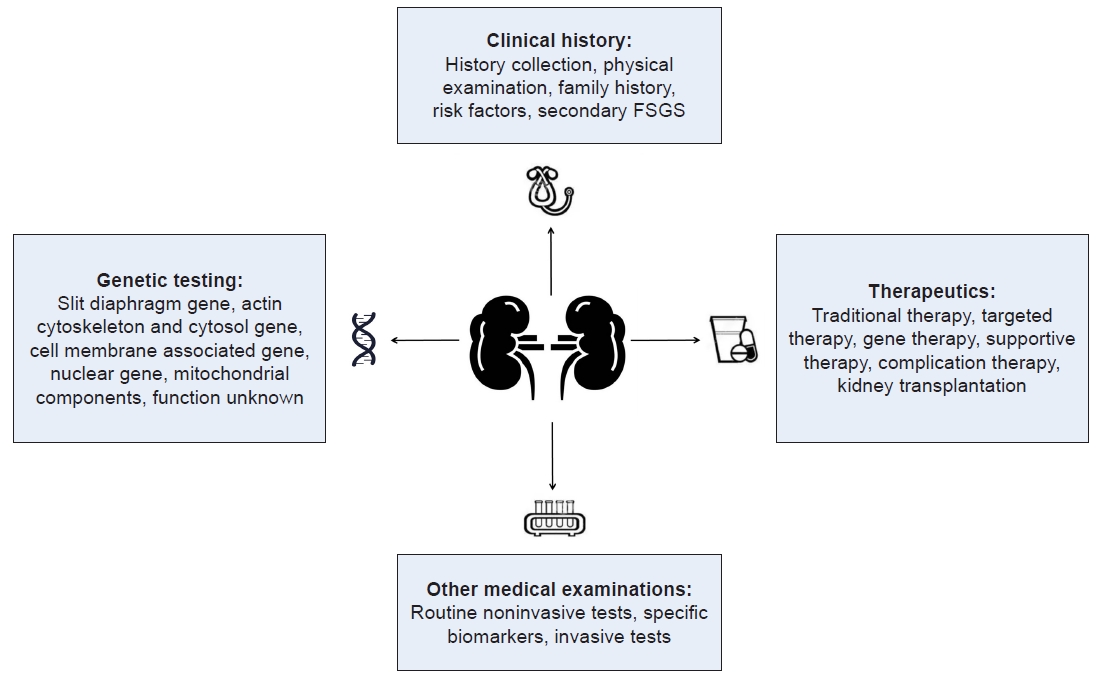
Focal segmental glomerulosclerosis (FSGS) is one of the common causes of nephrotic syndrome in adults and children worldwide. FSGS consists of a group of kidney diseases classified based on specific histopathological features. The current classification of FSGS makes it difficult to distinguish individual differences in pathogenesis, disease progression, and response to treatment. In recent years, the spread of next-generation sequencing,... -
DOI: https://doi.org/10.23876/j.krcp.23.227 [Epub ahead of print]
- Pathogenesis and management of renal fibrosis induced by unilateral ureteral obstruction
- Qi Yan Nan, Shang Guo Piao, Ji Zhe Jin, Byung Ha Chung, Chul Woo Yang, Can Li
- Received June 15, 2023 Accepted November 10, 2023
-

Regardless of the underlying etiology, renal fibrosis is the final histological outcome of progressive kidney disease. Unilateral ureteral obstruction (UUO) is an ideal and reproducible experimental rodent model of renal fibrosis, which is characterized by tubulointerstitial inflammatory responses, accumulation of extracellular matrix, tubular dilatation and atrophy, and fibrosis. The magnitude of UUO-induced renal fibrosis is experimentally manipulated by the species... -
DOI: https://doi.org/10.23876/j.krcp.23.156 [Epub ahead of print]
- Urinary podocyte markers in diabetic kidney disease
- Chuanlei Li, Cheuk-Chun Szeto
- Received May 1, 2023 Accepted October 30, 2023
-

Podocytes are involved in maintaining kidney function and are a major focus of research on diabetic kidney disease (DKD). Urinary biomarkers derived from podocyte fragments and molecules have been proposed for the diagnosis and monitoring of DKD. Various methods have been used to detect intact podocytes and podocyte-derived microvesicles in urine, including centrifugation, visualization, and molecular quantification. Quantification of podocyte-specific... -
DOI: https://doi.org/10.23876/j.krcp.23.109 [Epub ahead of print]
- Original Articles
- Triglyceride-glucose index is an independent predictor of coronary artery calcification progression in patients with chronic kidney disease
- Ye Eun Ko, Hyung Woo Kim, Jung Tak Park, Seung Hyeok Han, Shin-Wook Kang, Suah Sung, Kyu-Beck Lee, Joongyub Lee, Kook-Hwan Oh, Tae-Hyun Yoo
- Received October 24, 2023 Accepted November 17, 2023
-
Background: Coronary artery calcification (CAC) is highly prevalent in patients with chronic kidney disease (CKD) and is associated with major adverse cardiovascular events and metabolic disturbances. The triglyceride-glucose index (TyGI), a novel surrogate marker of metabolic syndrome and insulin resistance, is associated with CAC in the general population and in patients with diabetes. This study investigated the association between the... -
DOI: https://doi.org/10.23876/j.krcp.23.264 [Epub ahead of print]
- Obesity exacerbates ischemia-reperfusion injury and senescence in murine kidneys and perirenal adipose tissues
- Seo Rin Kim, Young-Suk Kim, Je Min Hyeon, Su Ji Kim, Byung Min Ye, Min Jeong Kim, Byung Hyun Choi, Dongwon Yi, Il Young Kim, Soo Bong Lee, Dong Won Lee
- Received August 25, 2022 Accepted February 3, 2023
-
Background: Obesity is a major worldwide health problem and can be related to cellular senescence. Along with the rise in obesity, the comorbidity of renal ischemia-reperfusion (IR) injury is increasing. Whether obesity accelerates the severity of IR injury and whether senescence contributes to these conditions remain unclear. We studied the degree of injury and cellular senescence in the IR kidneys... -
DOI: https://doi.org/10.23876/j.krcp.22.193 [Epub ahead of print]
- Longitudinal progression trajectory of estimated glomerular filtration rate in children with chronic kidney disease: results from the KNOW-Ped CKD (KoreaN cohort study for Outcomes in patients With Pediatric Chronic Kidney Disease)
- Eun Mi Yang, Jayoun Kim, Eujin Park, Kyoung Hee Han, Seong Heon Kim, Heeyeon Cho, Jae Il Shin, Min Hyun Cho, Joo Hoon Lee, Ji Hyun Kim, Hee Gyung Kang, Il-Soo Ha, Yo Han Ahn
- Received July 24, 2023 Accepted December 1, 2023
-
Background: The natural course of chronic kidney disease (CKD) progression in children varies according to their underlying conditions. This study aims to identify different patterns of subsequent decline in kidney function and investigate factors associated with different patterns of estimated glomerular filtration rate (eGFR) trajectories. Methods: We analyzed data from the KNOW-Ped CKD (KoreaN cohort study for Outcomes in patients With... -
DOI: https://doi.org/10.23876/j.krcp.23.198 [Epub ahead of print]
- Impact of obesity on renal function in elderly Korean adults: a national population-based cohort study
- Jihyun Yang, Hui Seung Lee, Chi-Yeon Lim, Hyunsuk Kim, Sungjin Chung, Soon Hyo Kwon, Jang-Hee Cho, Kyung Don Yoo, Woo Yeong Park, In O Sun, Byung Chul Yu, Gang-Jee Ko, Jae Won Yang, Won Min Hwang, Sang Heon Song, Sung Joon Shin, Yu Ah Hong, Eunjin Bae, Young Youl Hyun
- Received July 14, 2023 Accepted December 1, 2023
-
Background: Obesity is a well-known risk factor for chronic kidney disease and its progression. However, the impact of obesity on the renal function of the elderly population is uncertain. We investigated the association between obesity and renal outcomes in the elderly. Methods: We analyzed 130,504 participants from the Korean National Health Insurance Service-Senior cohort. Obesity was classified according to body... -
DOI: https://doi.org/10.23876/j.krcp.23.187 [Epub ahead of print]
- Remaining life expectancy of Korean hemodialysis patients: how much longer can they live?
- Hayne Cho Park, Do Hyoung Kim, AJin Cho, Bo Yeon Kim, Miri Lee, Gui Ok Kim, Jinseog Kim, Young-Ki Lee
- Received September 11, 2023 Accepted November 9, 2023
-
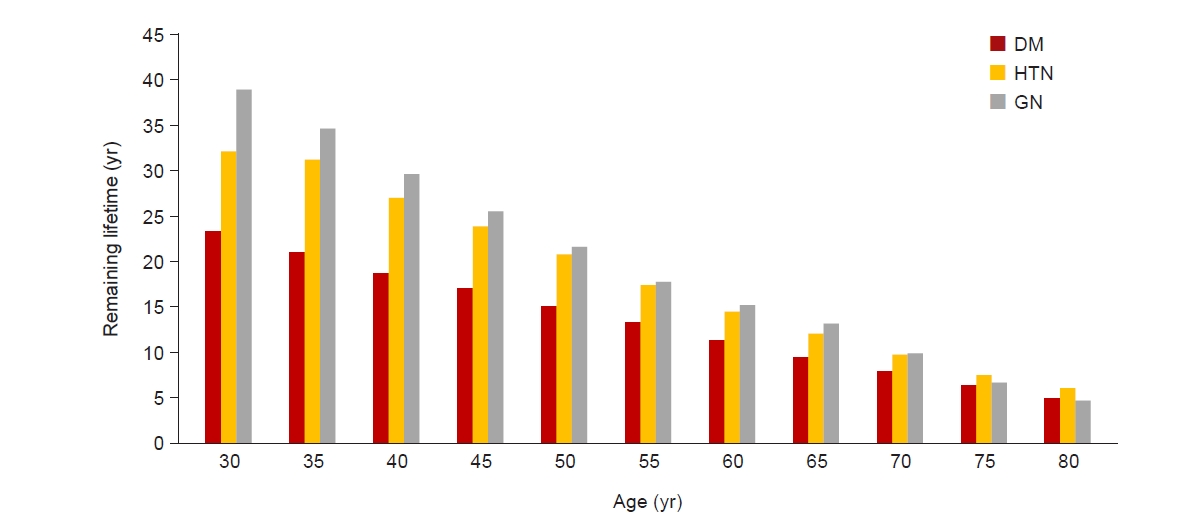
Background: Hemodialysis (HD) patients have a higher mortality rate compared to the general population. However, no study has investigated life expectancy in Korean HD patients so far. Therefore, this study aimed to calculate the remaining life expectancy among Korean maintenance HD patients and compare it to those of the general population as well as HD patients from other countries. Methods: Baseline... -
DOI: https://doi.org/10.23876/j.krcp.23.241 [Epub ahead of print]
- Intradialytic hypotension and worse outcomes in patients with acute kidney injury requiring intermittent hemodialysis
- Yeong-Won Park, Donghwan Yun, Yeojin Yu, Sang Hyun Kim, Sehoon Park, Yong Chul Kim, Dong Ki Kim, Kook-Hwan Oh, Kwon Wook Joo, Yon Su Kim, Seong Geun Kim, Seung Seok Han
- Received July 16, 2023 Accepted November 9, 2023
-
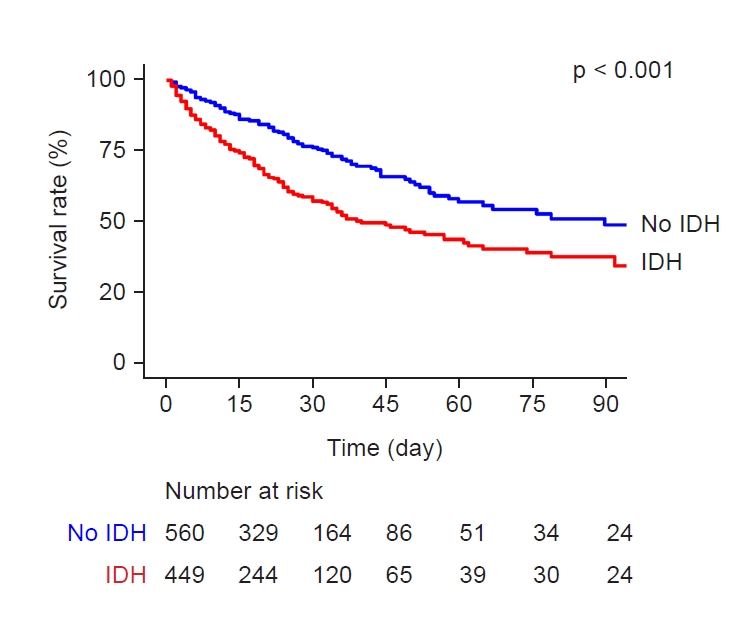
Background: Intradialytic hypotension (IDH) is a critical complication related to worse outcomes in patients undergoing maintenance hemodialysis. Herein, we addressed the impact of IDH on mortality and other outcomes in patients with severe acute kidney injury (AKI) requiring intermittent hemodialysis. Methods: We retrospectively reviewed 1,009 patients who underwent intermittent hemodialysis due to severe AKI. IDH was defined as either dialysis discontinuation... -
DOI: https://doi.org/10.23876/j.krcp.23.188 [Epub ahead of print]
- Anti-SARS-CoV-2 spike antibody response to the third dose of BNT162b2 mRNA COVID-19 vaccine and associated factors in Japanese hemodialysis patients
- Keiji Hirai, Masako Shimotashiro, Toshiaki Okumura, Susumu Ookawara, Yoshiyuki Morishita
- Received May 13, 2023 Accepted September 19, 2023
-
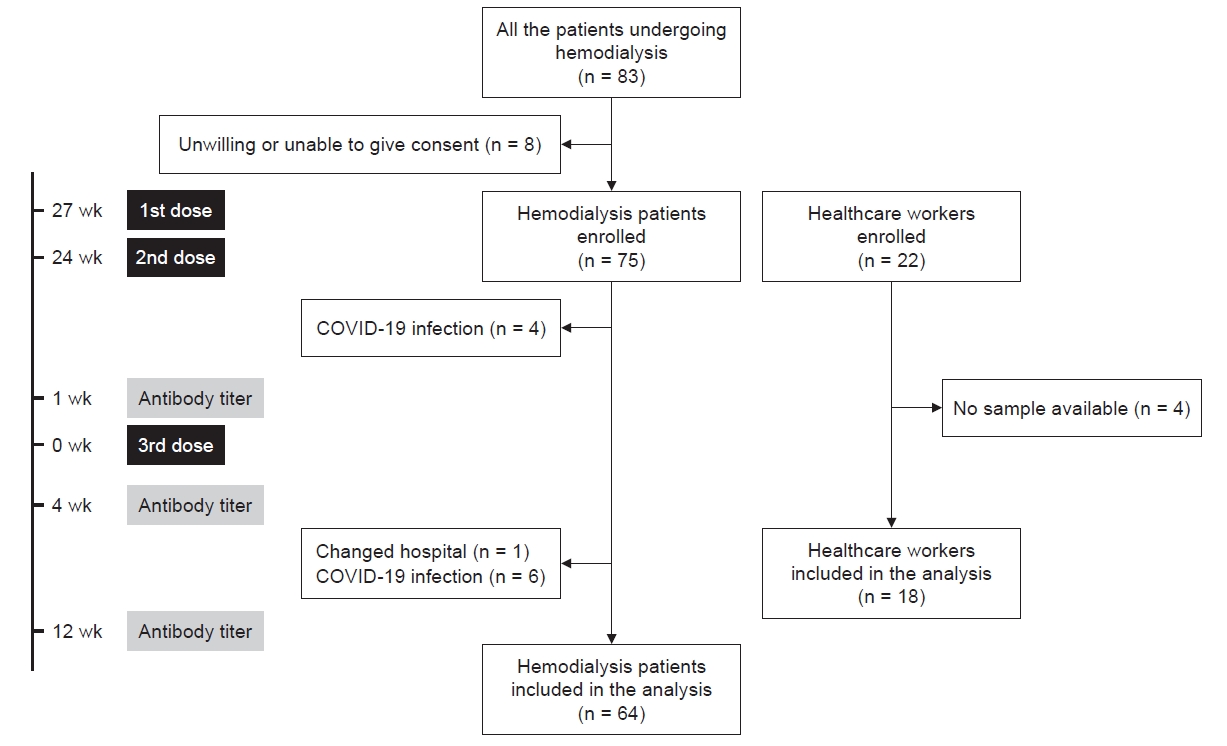
Background: We assessed the anti-SARS-CoV-2 spike antibody response to the third dose of BNT162b2 mRNA COVID-19 vaccine in Japanese hemodialysis patients and determined factors associated with the anti-SARS-CoV-2 spike antibody titer after the third dose of COVID-19 vaccine. Methods: Overall, 64 patients (37 males, 27 females; mean age 71.4 ± 11.7 years) were enrolled in this single-center, prospective, longitudinal study. Anti-SARS-CoV-2... -
DOI: https://doi.org/10.23876/j.krcp.23.121 [Epub ahead of print]
- Immediate-start peritoneal dialysis without break-in-period: an 18-year retrospective cohort study on patient survival
- Jee Young Lee, Hyun-Jin Cho, Yoo-Sun Joo, Hye-Jin Na, Jung-Hwan Park, Young-Il Jo
- Received April 28, 2023 Accepted November 8, 2023
-
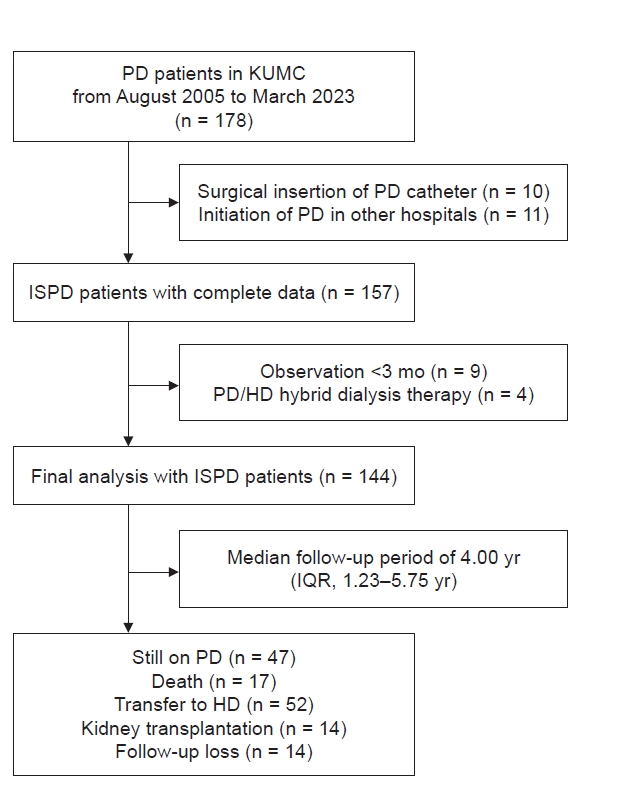
Background: Immediate-start peritoneal dialysis (ISPD) is an effective renal replacement therapy that can prevent central venous catheterization due to its immediate initiation of peritoneal dialysis (PD) after catheter insertion without a break-in period. This study aimed to investigate the effect of ISPD on long-term patient survival. Methods: In this retrospective single-center cohort study, 178 consecutive patients who started PD from August... -
DOI: https://doi.org/10.23876/j.krcp.23.103 [Epub ahead of print]
- Comparison between characteristics of immunoglobulin M nephropathy and other glomerular diseases
- Giae Yun, Eun Jeong Kwon, Seokwoo Park, Jong Cheol Jeong, Sejoong Kim, Ki Young Na, Ho Jun Chin
- Received June 14, 2023 Accepted August 5, 2023
-
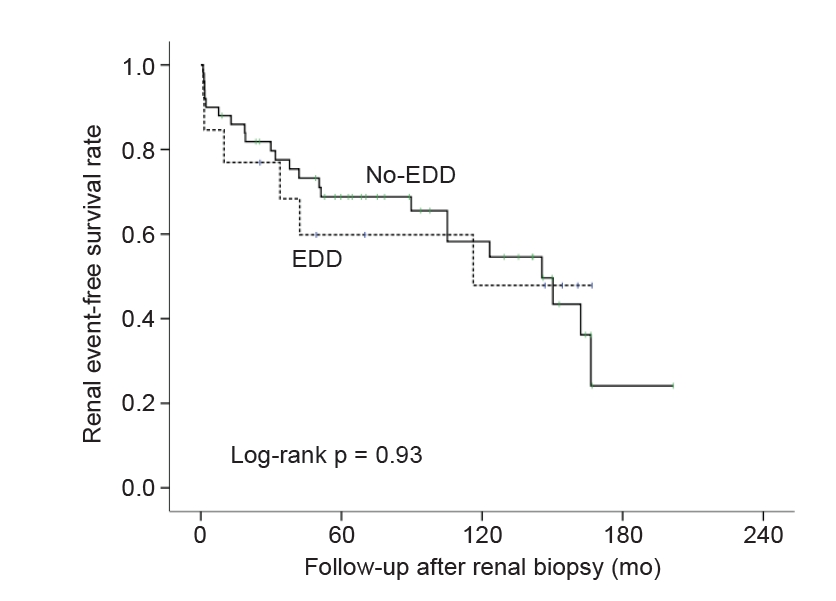
Background: Immunoglobulin M (IgM) nephropathy (IgMN) is characterized by the IgM deposition in the kidney’s mesangium. We assessed the impact of electron-dense deposits (EDDs) on IgMN and compared it to other kidney diseases. Methods: We enrolled 63 adult patients with IgMN who underwent renal biopsy from May 2003 to June 2017. We compared clinicopathological features of IgMN based on EDD presence;... -
DOI: https://doi.org/10.23876/j.krcp.23.159 [Epub ahead of print]
- Preliminary evaluation of the effect of revised reimbursement scheme in outpatient hemodialysis for medical aid recipients in Korea
- Heenyun Kim, Yongseok Choi, Soontack Kwon, Kook Young Jang, Do Kyung Ryuk, Hyejin Lee, Jin Yong Lee
- Received February 17, 2023 Accepted July 26, 2023
-

Background: South Korea has universal health coverage guaranteeing equitable healthcare for all. However, equity issues have been raised regarding hemodialysis reimbursement for medical aid recipients with chronic kidney disease. Physicians and civic groups demanded a revision of the discriminatory policy, and in response, the Ministry of Health and Welfare amended the hemodialysis case payment scheme. This study aims to evaluate... -
DOI: https://doi.org/10.23876/j.krcp.23.038 [Epub ahead of print]
- Mortality associated with the neutrophil-lymphocyte ratio in septic acute kidney injury requiring continuous renal replacement therapy
- Jinwoo Lee, Jeongin Song, Seong Geun Kim, Donghwan Yun, Min Woo Kang, Dong Ki Kim, Kook-Hwan Oh, Kwon Wook Joo, Yon Su Kim, Seung Seok Han, Yong Chul Kim
- Received May 12, 2023 Accepted October 24, 2023
-
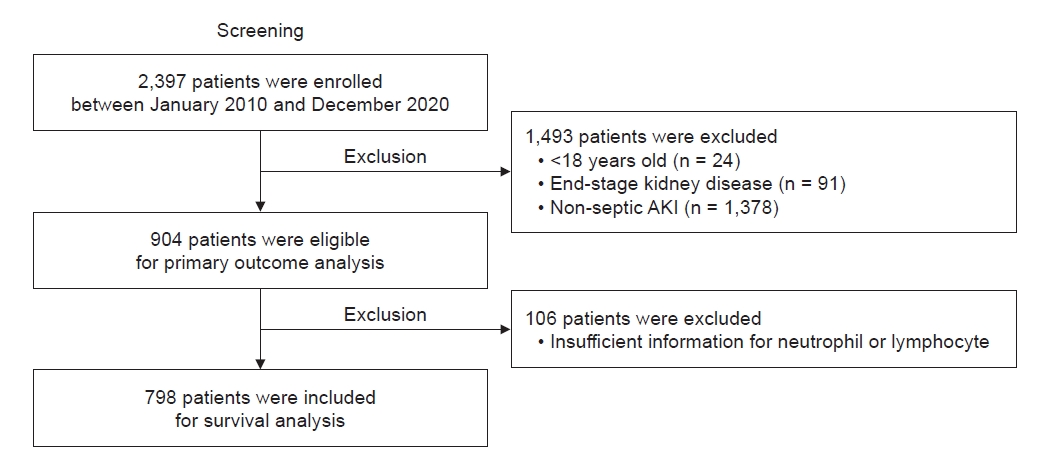
Background: Sepsis is an important cause of acute kidney injury in intensive care unit patients, accounting for 15% to 20% of renal replacement therapy prescriptions. The neutrophil-lymphocyte ratio (NLR), a maker of systemic inflammation and immune response, was previously associated with the mortality rate in multiple conditions. Herein, we aimed to examine how the NLR relates to the mortality rate... -
DOI: https://doi.org/10.23876/j.krcp.23.116 [Epub ahead of print]
- Association between dementia diagnosis at dialysis initiation and mortality in older patients with end-stage kidney disease in South Korea
- Byung Min Ye, Seongmin Kang, Woo Yeong Park, Jang-Hee Cho, Byung Chul Yu, Miyeun Han, Sang Heon Song, Gang-Jee Ko, Jae Won Yang, Sungjin Chung, Yu Ah Hong, Young Youl Hyun, Eunjin Bae, In O Sun, Hyunsuk Kim, Won Min Hwang, Sung Joon Shin, Soon Hyo Kwon, Seo Rin Kim, Kyung Don Yoo
- Received June 9, 2023 Accepted October 22, 2023
-
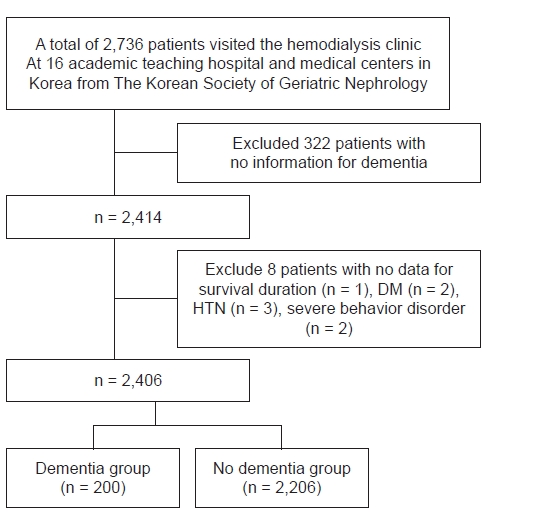
Background: The prevalence of dementia is 2- to 7-fold higher among patients with end-stage kidney disease (ESKD) than among the general population; however, its clinical implications in this population remain unclear. Therefore, this study aimed to determine whether comorbid dementia increases mortality among older patients with ESKD undergoing newly initiated hemodialysis. Methods: We analyzed data from the Korean Society... -
DOI: https://doi.org/10.23876/j.krcp.23.151 [Epub ahead of print]
- Efficacy of intradialytic neuromuscular electrical stimulation and oral nutritional supplementation in hemodialysis patients: a multicenter, randomized controlled trial
- Jae Hyeon Park, Jae Yoon Park, Geum Sil Lee, Ran-hui Cha
- Received June 2, 2023 Accepted October 2, 2023
-

Background: Sarcopenia is common in hemodialysis patients. This study aimed to evaluate the effect of simultaneous nutritional support and intradialytic neuromuscular electrical stimulation (NMES) in hemodialysis patients. Methods: We performed a 12-week, multicenter, randomized controlled trial. The participants were randomly assigned to the control group, the protein group (25 g of protein at every dialysis session), the NMES group (intradialytic... -
DOI: https://doi.org/10.23876/j.krcp.23.146 [Epub ahead of print]
- Performance evaluation of Chronic Kidney Disease Epidemiology Collaboration equations for estimated glomerular filtration rate compared to inulin clearance in Koreans
- Jeong Min Cho, Ran-hui Cha, Dong Ki Kim, Ho Jun Chin
- Received May 17, 2023 Accepted September 12, 2023
-

Background: A race-free glomerular filtration rate (GFR) estimation equation has recently been developed. However, the performance of the new Chronic Kidney Disease Epidemiology Collaboration (CKD-EPI) equations needs to be evaluated in Asian populations. Methods: We performed a cross-sectional study at a single center in South Korea. The measured GFR (mGFR) was determined based on systemic inulin clearance. The GFR was... -
DOI: https://doi.org/10.23876/j.krcp.23.124 [Epub ahead of print]
- Pericyte activation accompanied by peritubular capillaries dysfunction and pericyte-to-myofibroblast transition is associated with renal fibrosis in diabetic nephropathy
- Yiduo Feng, Dongli Tian, Yu Bai, Yan Li, Liling Zhang, Yiru Wu, Wenhu Liu, Zongli Diao
- Received April 19, 2023 Accepted October 2, 2023
-
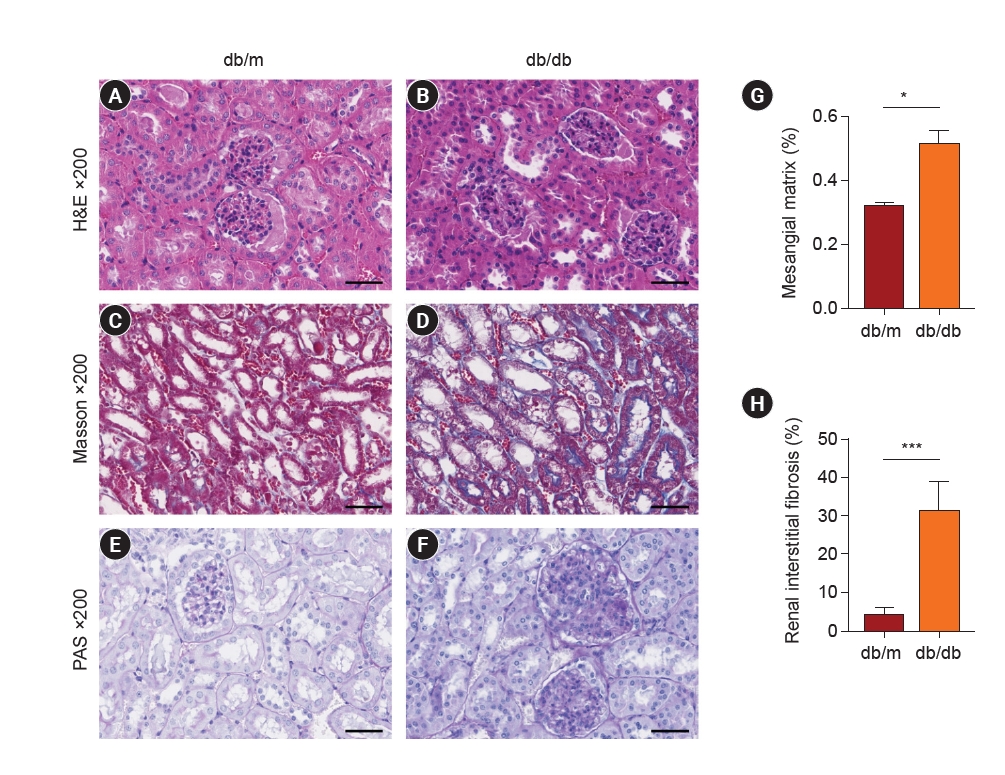
Background: Tubulointerstitial renal fibrosis is an essential feature of diabetic nephropathy (DN). Pericytes play a critical role in microvascular diseases and renal fibrogenesis. However, the role of pericytes in DN remains unclear. Herein, we aimed to explore the properties and possible mechanisms of pericytes in renal fibrosis in DN. Methods: We used multiplex immunofluorescence staining to evaluate the location and... -
DOI: https://doi.org/10.23876/j.krcp.23.099 [Epub ahead of print]
- Fasting blood glucose and the risk of all-cause mortality in patients with diabetes mellitus undergoing hemodialysis
- Soo-Young Yoon, Jin Sug Kim, Gang Jee Ko, Yun Jin Choi, Ju Young Moon, Kyunghwan Jeong, Hyeon Seok Hwang
- Received January 15, 2023 Accepted January 15, 2023
-

Background: Glycemic control is particularly important in hemodialysis (HD) patients with diabetes mellitus (DM). Although fasting blood glucose (FBG) level is an important indicator of glycemic control, a clear target for reducing mortality in HD patients with DM is lacking. Methods: A total of 26,162 maintenance HD patients with DM were recruited from the National Health Insurance Database of Korea between... -
DOI: https://doi.org/10.23876/j.krcp.23.098 [Epub ahead of print]
- Medium cut-off dialyzer improves reduction ratios of large middle molecules associated with vascular calcification
- Hyo Jin Kim, Eun Young Seong, Sang Heon Song
- Received March 15, 2023 Accepted July 31, 2023
-

Background: We aimed to investigate the change in the large middle molecule (>15 kDa) removal rate, which is associated with vascular calcification, when using a medium cut-off (MCO) dialyzer compared to a high-flux (HF) dialyzer. Methods: Twenty patients with clinically stable maintenance hemodialysis were investigated over a 15-week study period. Dialyzer efficacies were evaluated during the last midweek hemodialysis treatment... -
DOI: https://doi.org/10.23876/j.krcp.23.061 [Epub ahead of print]
- Efficacy and cost-effectiveness of darbepoetin alfa once every 4 weeks versus continuous erythropoietin receptor activator once every 4 weeks for anemia correction in patients with chronic kidney disease not on dialysis
- Geo Neul Park, Kyung Ho Lee, Ji Eun Moon, Soo Jeong Choi, Moo Yong Park, Jin Kuk Kim, Byung Chul Yu
- Received March 28, 2023 Accepted September 5, 2023
-

Background: For anemia management in patients with chronic kidney disease not on dialysis, darbepoetin alfa (DA), which has a shorter half-life but is more inexpensive than continuous erythropoietin receptor activator (CERA), is preferred in Korea. This study evaluated the efficacy, safety, and cost-effectiveness of once-in-4-weeks DA compared with once-in-4-weeks CERA in patients with chronic kidney disease not on dialysis. Methods: In... -
DOI: https://doi.org/10.23876/j.krcp.23.074 [Epub ahead of print]
- Associations of metabolic variabilities and cardiovascular outcomes according to estimated glomerular filtration rate in chronic kidney disease: a nationwide observational cohort study
- Jeong Min Cho, Kyungdo Han, Kwon Wook Joo, Soojin Lee, Yaerim Kim, Semin Cho, Hyuk Huh, Seong Geun Kim, Minsang Kim, Eunjeong Kang, Dong Ki Kim, Sehoon Park
- Received May 24, 2023 Accepted August 16, 2023
-

Background: The impact of baseline estimated glomerular filtration rate (eGFR) on the risk of adverse outcomes according to metabolic parameter variabilities in chronic kidney disease has rarely been investigated. Methods: We conducted a retrospective nationwide cohort study using the National Health Insurance System data in Korea from 2007 to 2013 to identify individuals with three or more health screenings. The metabolic... -
DOI: https://doi.org/10.23876/j.krcp.23.135 [Epub ahead of print]
- Association of metformin with cardiovascular and graft outcomes in kidney transplant recipients with posttransplantation diabetes mellitus
- Dongyeon Lee, Jiyun Jung, Sichan Kim, Jaeyun Lee, Jangwook Lee, Chung Hee Baek, Hyunwook Kwon, Sung Shin, Younghoon Kim, Sung Joon Shin, Su-Kil Park, Jae Yoon Park, Hyosang Kim
- Received April 10, 2023 Accepted August 28, 2023
-
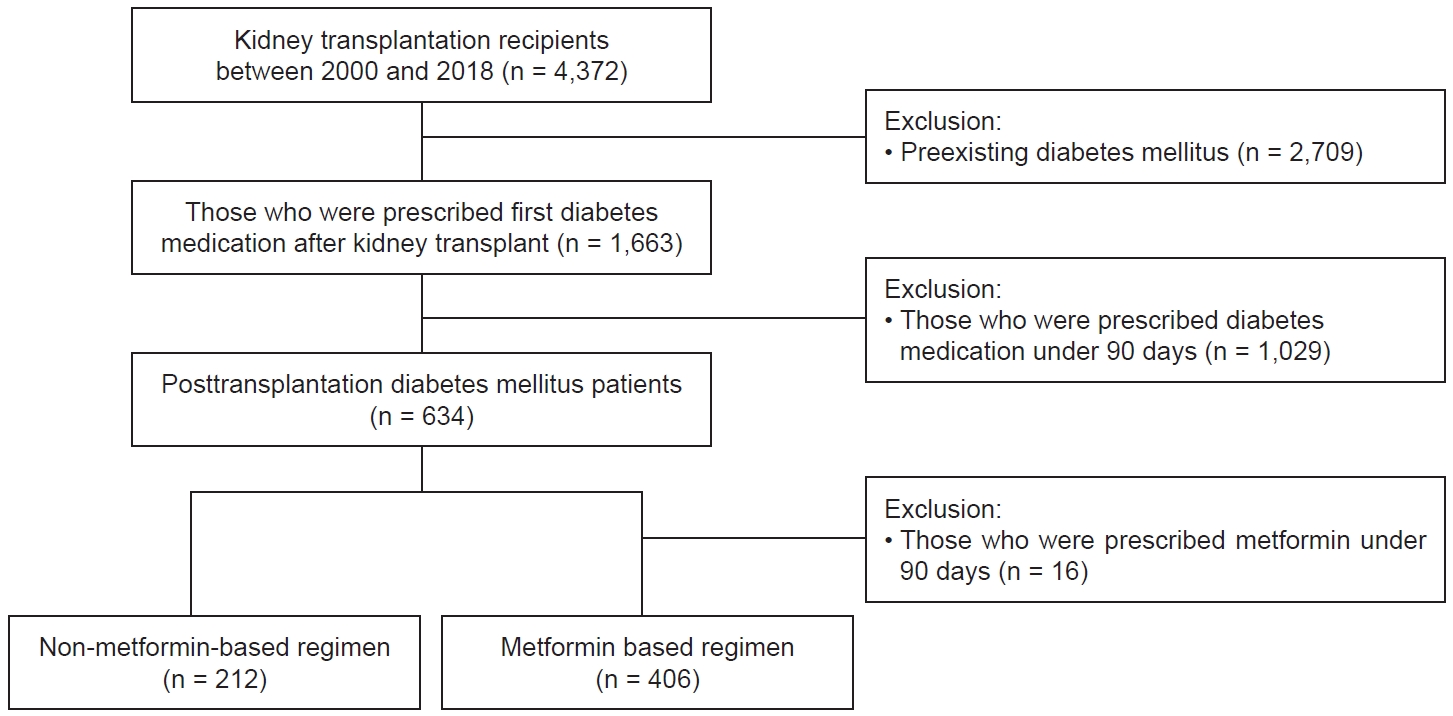
Background: Posttransplantation diabetes mellitus (PTDM) is a crucial problem after kidney transplantation. We aimed to determine whether metformin affects cardiovascular and graft outcomes in patients with PTDM. Methods: This retrospective cohort study included 1,663 kidney transplant recipients without preexisting diabetes mellitus. The patients were divided into metformin and non-metformin groups, with matched propensity scores. We also estimated metformin’s effect on percutaneous... -
DOI: https://doi.org/10.23876/j.krcp.23.085 [Epub ahead of print]
- Kidney biopsy can help to predict renal outcomes of patients with type 2 diabetes mellitus
- Wook-Joon Kim, Taehoon Oh, Nam Hun Heo, Kyungsup Kwon, Ga-Eun Shin, Se-Hwi Jeong, Ji Hye Lee, Samel Park, Nam-Jun Cho, Hyo-Wook Gil, Eun Young Lee
- Received March 13, 2023 Accepted July 30, 2023
-
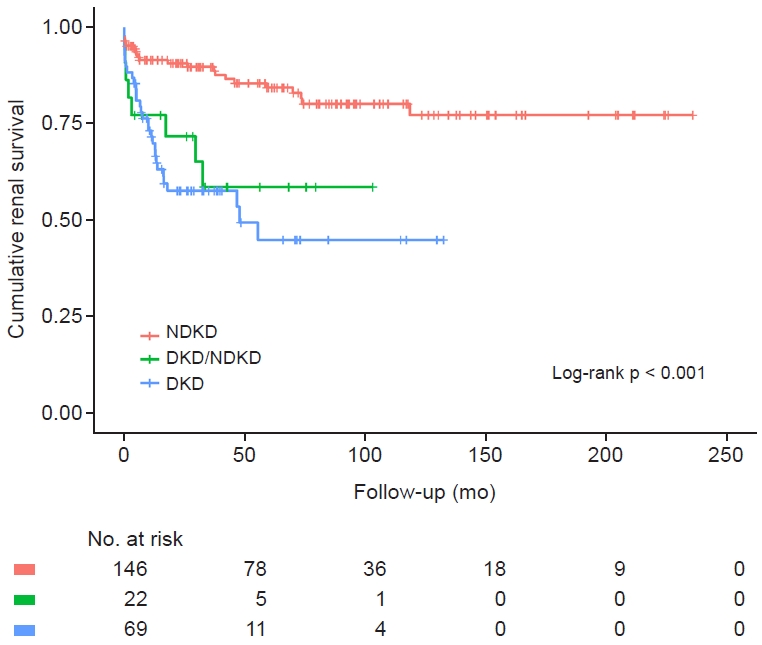
Background: In patients with type 2 diabetes mellitus (T2DM), diabetic kidney disease (DKD) is diagnosed based on clinical features. A kidney biopsy is used only in selected cases. This study aimed to reconsider the role of a biopsy in predicting renal outcomes. Methods: Clinical and laboratory parameters and renal biopsy results were obtained from 237 patients with T2DM who underwent renal... -
DOI: https://doi.org/10.23876/j.krcp.23.059 [Epub ahead of print]
- Maternal exposure to airborne particulate matter during pregnancy and lactation induces kidney injury in rat dams and their male offspring: the role of vitamin D in pregnancy and beyond
- Min Hwa Son, Eujin Park, Hyung Eun Yim, Yoon Jeong Nam, Yu-Seon Lee, Eui Kyung Choi, Sang Hoon Jeong, Ju‑Han Lee
- Received May 3, 2023 Accepted August 6, 2023
-

Background: Little is known about the transgenerational effects of maternal exposure to fine particulate matter (PM2.5) on offspring kidney health. This study investigated the effect of maternal administration of PM2.5 or PM2.5 with vitamin D during pregnancy and lactation on renal injury in rat dams and their offspring. Methods: Nine pregnant Sprague-Dawley rats received oral administration of normal saline, airborne PM2.5,... -
DOI: https://doi.org/10.23876/j.krcp.23.106 [Epub ahead of print]
- Long-term outcomes and associated prognostic risk factors of childhood-onset lupus nephritis
- Eujin Park, Jiwon Jung, Jeesu Min, Hyeonju Lee, Min Ji Park, Ji Yeon Song, Ji Hyun Kim, Kyung Mi Jang, Eun Mi Yang, Yo Han Ahn, Min Hyun Cho, Joo Hoon Lee, Young Seo Park, Soon Chul Kim, Se Jin Park, Jung Won Lee, Kee Hyuck Kim, Ki Soo Pai, Hee Gyung Kang, Seong Heon Kim
- Received February 15, 2023 Accepted August 14, 2023
-
Background: This study investigated the clinical characteristics and kidney outcomes of childhood-onset lupus nephritis (LN), and risk factors associated with prognosis. Methods: We enrolled 216 patients with histologically diagnosed LN during childhood. The Korean Society of Pediatric Nephrology organized a retrospective cohort study of childhood-onset LN in 13 major pediatric nephrology centers in South Korea. Results: The mean age at... -
DOI: https://doi.org/10.23876/j.krcp.23.032 [Epub ahead of print]
- Association between hearing loss and physical performance in patients on maintenance hemodialysis
- Weifeng Fan, Xiaojing Zhong, Qing Wu, Lihong Zhang, Zhenhao Yang, Yong Gu, Qi Guo, Xiaoyu Chen, Chen Yu, Kun Zhang, Wei Ding, Hualin Qi, Junli Zhao, Liming Zhang, Suhua Zhang, Jianying Niu
- Received October 11, 2022 Accepted June 20, 2023
-

Background: The correlation between hearing loss (HL) and physical performance in patients receiving maintenance hemodialysis (MHD) remains poorly investigated. This study explored the association between HL and physical performance in patients on MHD. Methods: This multicenter cross-sectional study was conducted between July 2020 and April 2021 in seven hemodialysis centers in Shanghai and Suzhou, China. The hearing assessment was performed... -
DOI: https://doi.org/10.23876/j.krcp.22.231 [Epub ahead of print]
- Insulin resistance is associated with incident chronic kidney disease in population with normal renal function
- Su Hyun Song, Young Jin Goo, Tae Ryom Oh, Sang Heon Suh, Hong Sang Choi, Chang Seong Kim, Seong Kwon Ma, Soo Wan Kim, Eun Hui Bae
- Received December 23, 2022 Accepted June 20, 2023
-

Background: Insulin resistance is prevalent in chronic kidney disease and may accelerate the progression of chronic kidney disease. This study aimed to investigate whether insulin resistance is associated with the development of incident chronic kidney disease in a population with normal renal function. Methods: A total of 3,331 participants from a community-based cohort with normal renal function were prospectively analyzed.... -
DOI: https://doi.org/10.23876/j.krcp.22.298 [Epub ahead of print]
- Long non-coding RNA MEG3 silencing weakens high glucose-induced mesangial cell injury by decreasing LIN28B expression by sponging and sequestering miR-23c
- Lu Rong, Huanzhou Xue, Jianwei Hao, Jianjun Liu, Hao Xu
- Received April 11, 2023 Accepted July 20, 2023
-
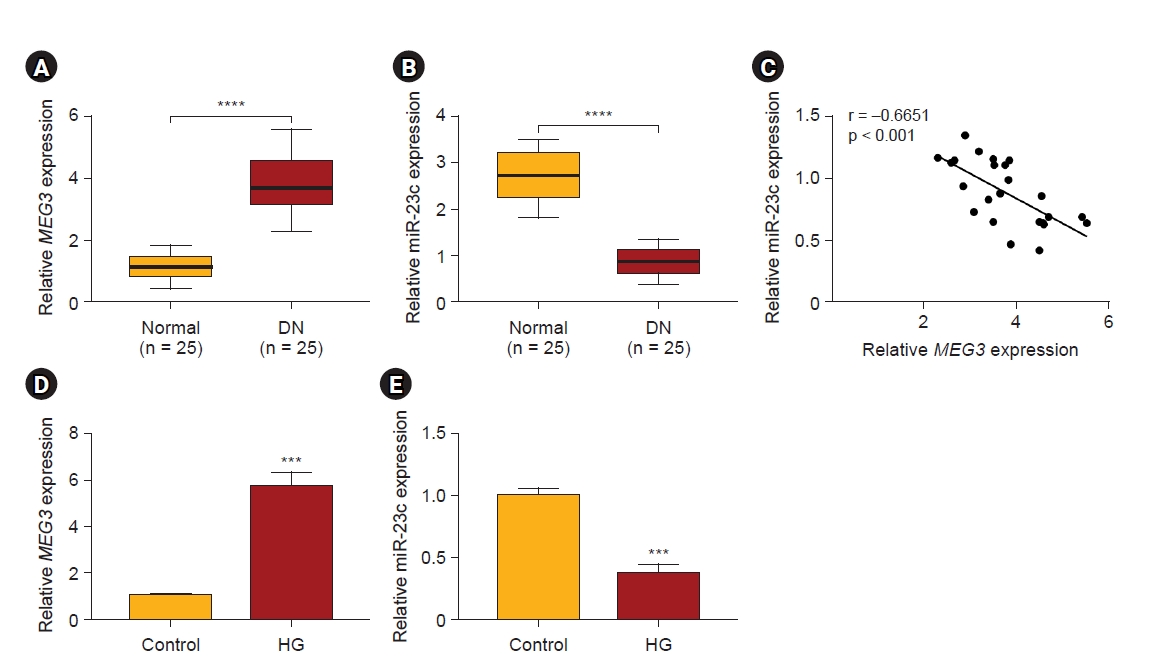
Background: Diabetic nephropathy (DN) is a common kidney disease in diabetic patients. Long non-coding RNA maternally expressed gene 3 (MEG3) and microRNA (miR)-23c are reported to be implicated in DN development. Nevertheless, it is unclear that the molecular mechanism between MEG3 and miR-23c in DN remains unclear. Methods: Human mesangial cells (HMCs) were treated with high glucose (HG) to simulate... -
DOI: https://doi.org/10.23876/j.krcp.23.090 [Epub ahead of print]
- Impact of albuminuria on early-onset type 2 diabetes mellitus: a nationwide population-based study
- Soojin Lee, Semin Cho, Geum Nae Nam, Jeongmin Cho, Seong Geun Kim, Minsang Kim, Hyuk Huh, Eunjeong Kang, Sehoon Park, Jin Hyuk Paek, Woo Yeong Park, Kyubok Jin, Seungyeup Han, Kwon Wook Joo, Kyungdo Han, Dong Ki Kim, Yaerim Kim
- Received November 25, 2022 Accepted July 11, 2023
-
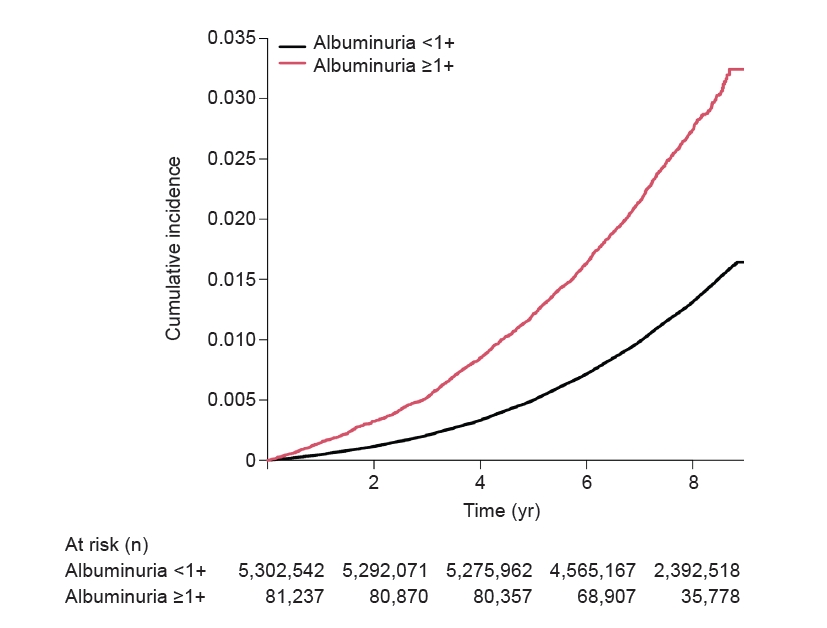
Background: Early-onset diabetes mellitus has a significant lifetime burden and is associated with higher morbidity and mortality. Since insulin resistance is one of the mechanisms of podocyte injury, we aimed to evaluate the effect of albuminuria on newly developed early-onset type 2 diabetes mellitus (T2DM). Methods: We screened 6,891,399 subjects aged ≥20 and <40 years without a history of prediabetes... -
DOI: https://doi.org/10.23876/j.krcp.22.278 [Epub ahead of print]
- Clinical influencing factors affecting pulmonary hypertension in hemodialysis patients
- Xu Zhang, Kun Xiao, Longkai Li, Nan Wang, Tao Cong, Yushan Wei, Shengji Cao, Xinyu Wen, Qingyang Meng, Hongli Lin, Taihua Wu
- Received February 2, 2023 Accepted May 4, 2023
-

Background: The fluid status and rate of blood flow through the arteriovenous fistula (AVF) are two important factors affecting hemodynamic in hemodialysis patients; however, their effects on pulmonary hypertension have rarely been studied. Hence, we aimed to evaluate the effects of these factors in hemodialysis patients with pulmonary hypertension. Methods: This single-center cross-sectional survey included 219 maintenance hemodialysis patients (139... -
DOI: https://doi.org/10.23876/j.krcp.23.021 [Epub ahead of print]
- Atherogenic indices and risk of chronic kidney disease in metabolic derangements: Gangnam Severance Medical Cohort
- Donghwan Oh, Seoyoung Lee, Eunji Yang, Hoon Young Choi, Hyeong Cheon Park, Jong Hyun Jhee
- Received February 21, 2023 Accepted July 3, 2023
-
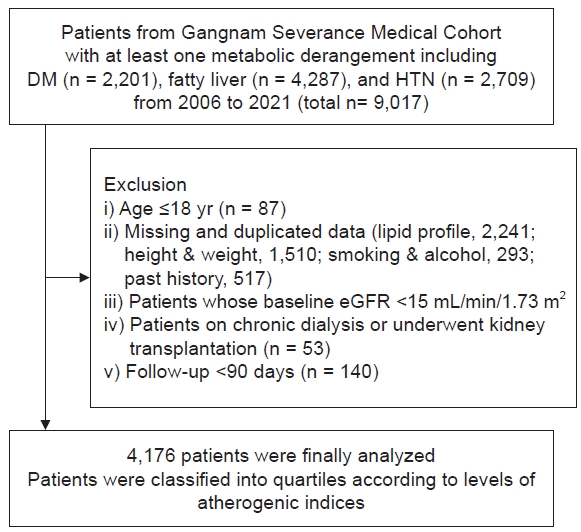
Background: The effects of atherogenic indices on kidney function remain unclear. This study evaluated the association between atherogenic indices and risk of chronic kidney disease (CKD) in adults with metabolic derangements. Methods: A total of 4,176 participants from the Gangnam Severance Medical Cohort (2006–2021), which consisted of participants who had at least one disease related to metabolic derangements including diabetes mellitus,... -
DOI: https://doi.org/10.23876/j.krcp.23.043 [Epub ahead of print]
- High water intake induces primary cilium elongation in renal tubular cells
- Min Jung Kong, Sang Jun Han, Sung Young Seu, Ki-Hwan Han, Joshua H. Lipschutz, Kwon Moo Park
- Received April 7, 2023 Accepted July 27, 2023
-
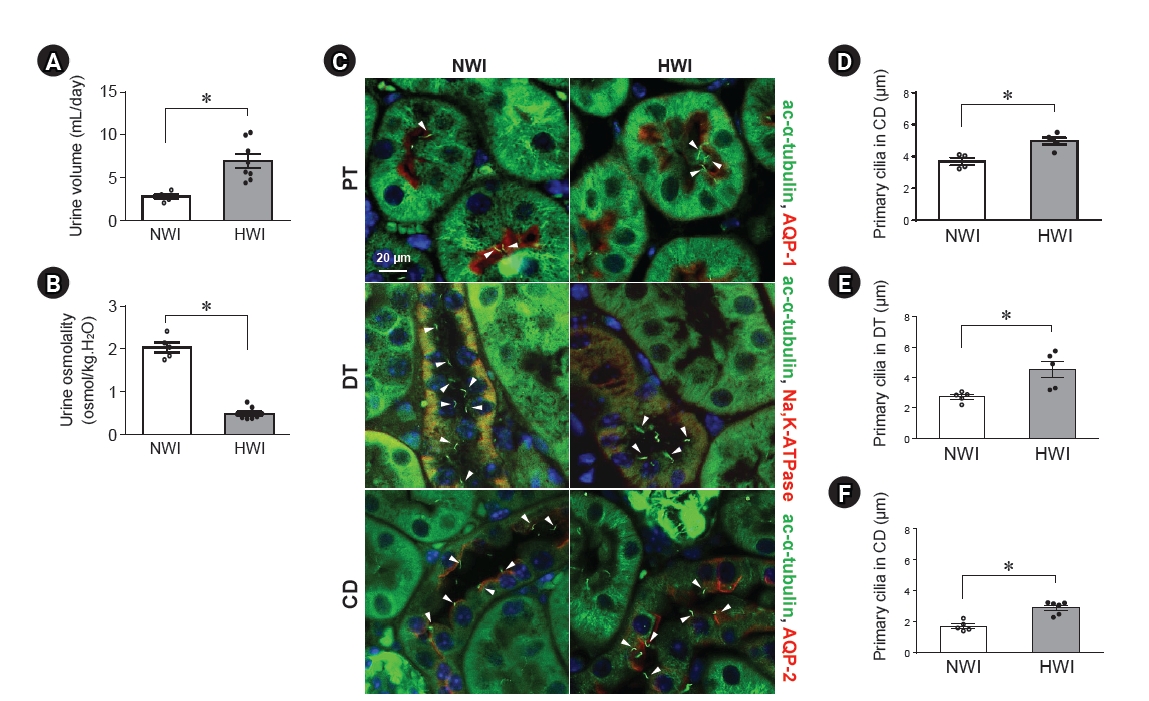
Background: The primary cilium protrudes from the cell surface and functions as a mechanosensor. Recently, we found that water intake restriction shortens the primary cilia of renal tubular cells, and a blockage of the shortening disturbs the ability of the kidneys to concentrate urine. Here, we investigate whether high water intake (HWI) alters primary cilia length, and if so, what... -
DOI: https://doi.org/10.23876/j.krcp.23.087 [Epub ahead of print]
- Association of systolic blood pressure with incident chronic kidney disease estimated by marginal structural model: a nationwide population-based study
- Hyunsun Lim, Youn Nam Kim, Tae Ik Chang, Jae Young Kim
- Received March 28, 2023 Accepted July 30, 2023
-

Background: We aimed to investigate the association between systolic blood pressure (SBP) and risk of incident chronic kidney disease (CKD) using marginal structural model (MSM) to reflect mutual effects of exposure and confounders on the outcome. Methods: A total of 195,970 adults with an estimated glomerular filtration rate (eGFR) of >60 mL/min/1.73 m2 and no proteinuria were included from... -
DOI: https://doi.org/10.23876/j.krcp.23.073 [Epub ahead of print]
- Genome-wide association study and fine-mapping on Korean biobank to discover renal trait-associated variants
- Dong-Jin Lee, Jong-Seok Moon, Dae Kwon Song, Yong Seok Lee, Dong-Sub Kim, Nam-Jun Cho, Hyo-Wook Gil, Eun Young Lee, Samel Park
- Received March 27, 2023 Accepted June 20, 2023
-
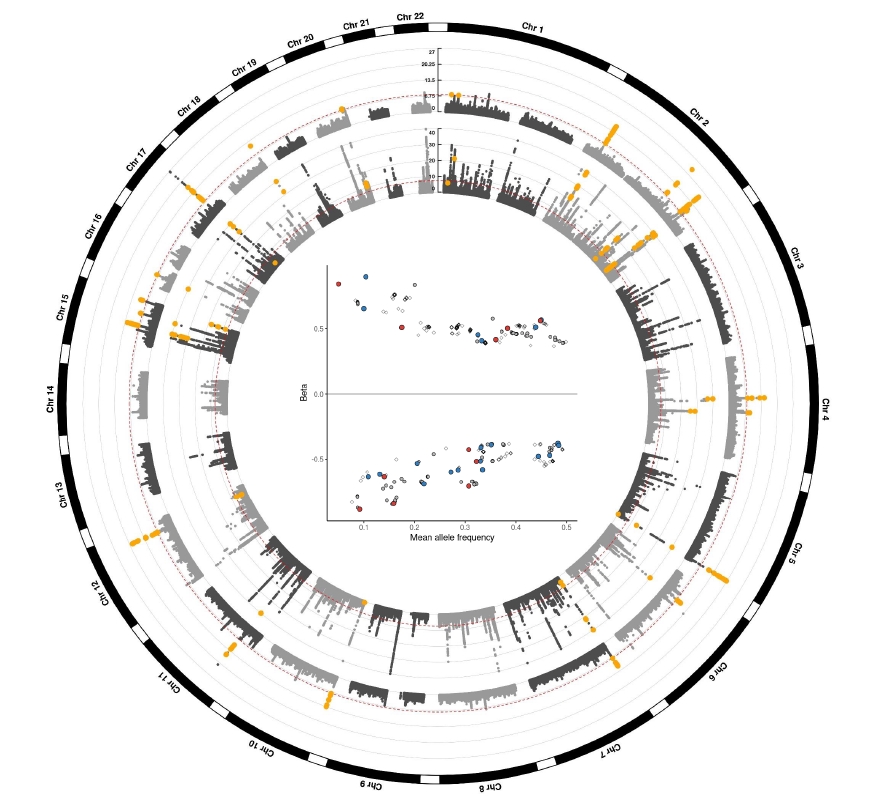
Background: Chronic kidney disease is a significant health burden worldwide, with increasing incidence. Although several genome-wide association studies (GWAS) have investigated single nucleotide polymorphisms (SNP) associated with kidney trait, most studies were focused on European ancestry. Methods: We utilized clinical and genetic information collected from the Korean Genome and Epidemiology Study (KoGES). Results: More than five million SNPs from 58,406 participants... -
DOI: https://doi.org/10.23876/j.krcp.23.079 [Epub ahead of print]
- Necessity of induction agent modification for old age kidney transplant recipients
- Kyeong Deok Kim, Kyo Won Lee, Jae Berm Park, Woo Sung Sim, Manuel Lim, Eun Sung Jeong, Jieun Kwon, Jaehun Yang
- Received March 21, 2023 Accepted July 4, 2023
-
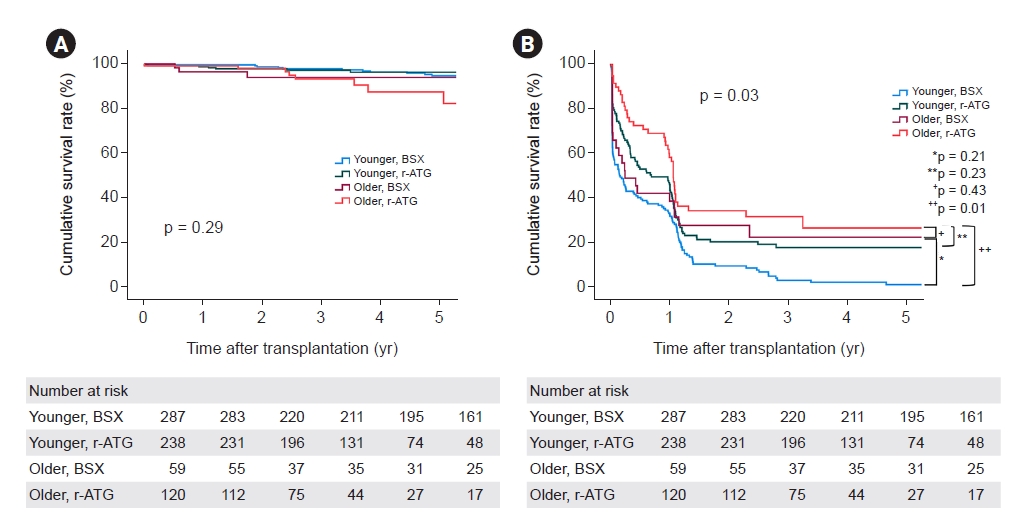
Background: Immunosenescence gradually deteriorates the function of the immune system, making elderly patients susceptible to infection, while reducing rejection of organ transplants. Therefore, age-adaptive immunosuppression is necessary in the elderly. We evaluated clinical outcomes such as rejection and infection rate when using basiliximab and rabbit anti-thymocyte globulin (r-ATG) as induction agents in elderly and young organ transplant recipients. Methods: We... -
DOI: https://doi.org/10.23876/j.krcp.23.068 [Epub ahead of print]
- Bowman capsule rupture in children with myeloperoxidase-antineutrophil cytoplasmic antibody-associated glomerulonephritis predicts poor renal survival
- Pei Zhang, Li-li Jia, Meng-zhen Fu, Kai-li Shi, Chun-lin Gao, Zheng-kun Xia
- Received March 6, 2023 Accepted May 25, 2023
-
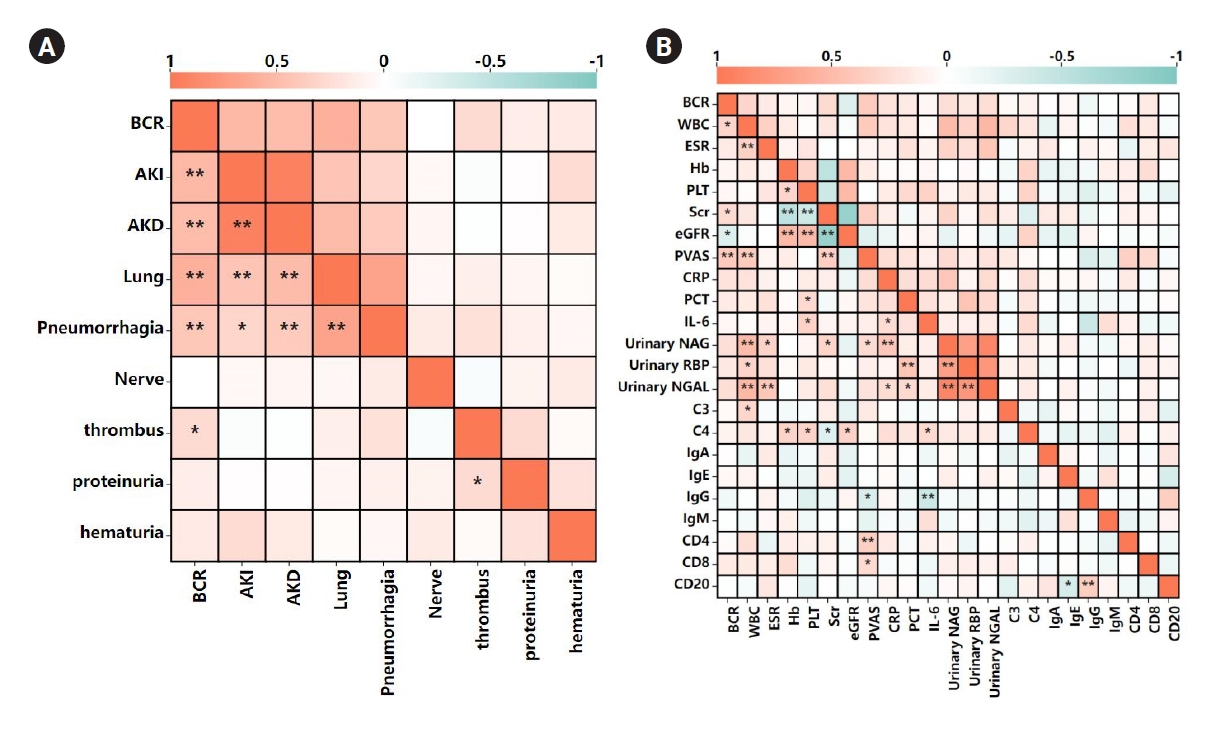
Background: Recent developments indicated that Bowman capsule rupture (BCR) is observed in antineutrophil cytoplasmic antibody (ANCA)-associated glomerulonephritis (AAGN). We aimed to explore the relationship between BCR and clinical manifestations, pathological changes, and prognosis in children with myeloperoxidase (MPO)-AAGN. Methods: A total of 56 children with MPO-AAGN were divided into BCR (+) and BCR (–) groups according to the status of Bowman’s... -
DOI: https://doi.org/10.23876/j.krcp.23.051 [Epub ahead of print]
- Target blood pressure in Korean hemodialysis patients for optimal survival
- Ji Eun Kim, Yun Jin Choi, Soon-Young Hwang, Hyeon Seok Hwang, Kyung Hwan Jeong, Eunjung Cho, Shin Young Ahn, Young Joo Kwon, Ju-Young Moon, Gang-Jee Ko
- Received October 12, 2022 Accepted March 23, 2023
-
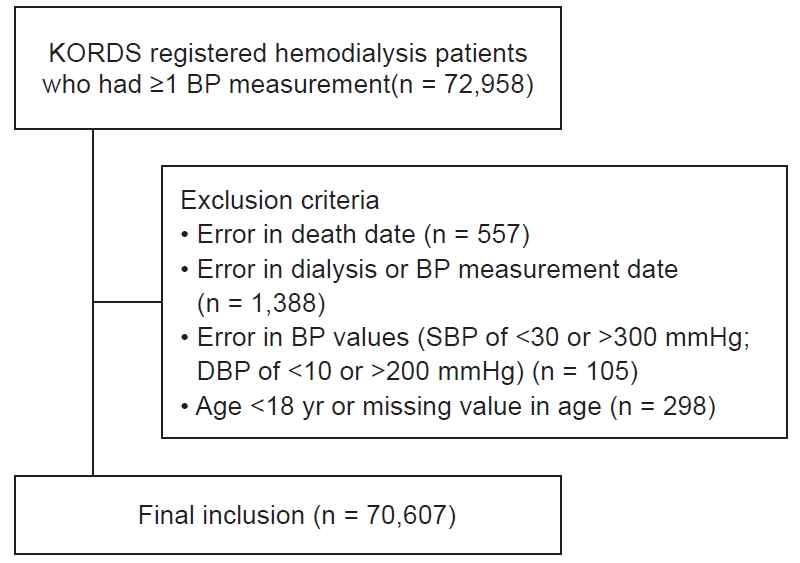
Background: Hypertension is a major cardiovascular risk factor in hemodialysis patients. This study identified the optimal blood pressure (BP) target for Korean hemodialysis patients using the Korean Renal Dialysis System (KORDS) dataset from the Korean Society of Nephrology and a pooled analysis for previous studies. Methods: Hemodialysis patients were classified according to their systolic (SBP) and diastolic BP (DBP) at intervals... -
DOI: https://doi.org/10.23876/j.krcp.22.241 [Epub ahead of print]
- Machine learning-based 2-year risk prediction tool in immunoglobulin A nephropathy
- Yujeong Kim, Jong Hyun Jhee, Chan Min Park, Donghwan Oh, Beom Jin Lim, Hoon Young Choi, Dukyong Yoon, Hyeong Cheon Park
- Received March 22, 2023 Accepted July 17, 2023
-
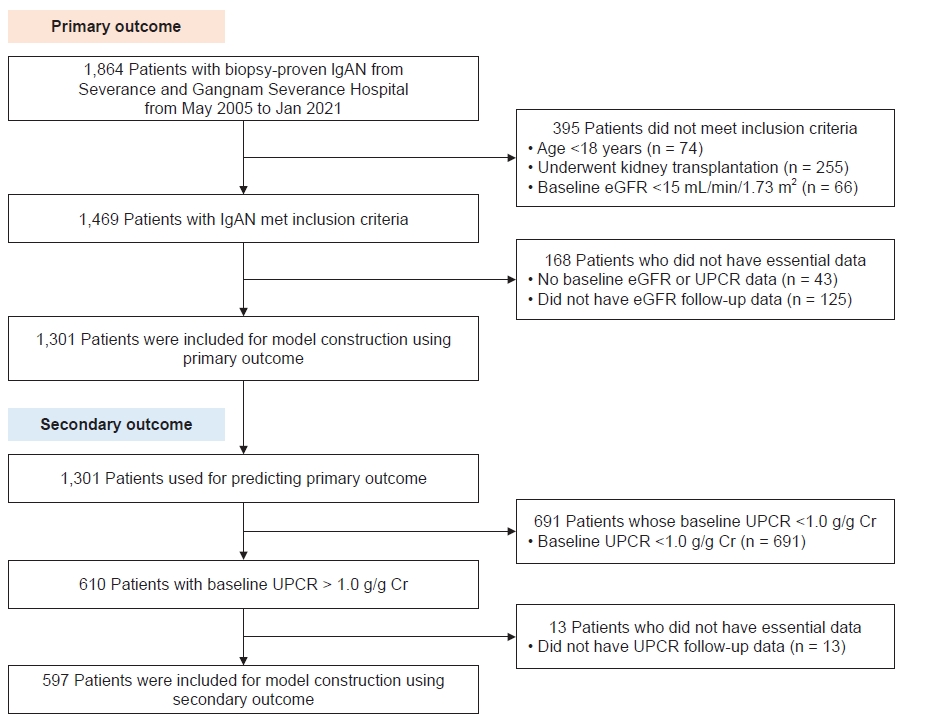
Background: This study aimed to develop a machine learning-based 2-year risk prediction model for early identification of patients with rapid progressive immunoglobulin A nephropathy (IgAN). We also assessed the model’s performance to predict the long-term kidney-related outcome of patients. Methods: A retrospective cohort of 1,301 patients with biopsy-proven IgAN from two tertiary hospitals was used to derive and externally validate a... -
DOI: https://doi.org/10.23876/j.krcp.23.076 [Epub ahead of print]
- Smoking amplifies the risk of albuminuria in individuals with high sodium intake: the Korea National Health and Nutrition Examination Survey (KNHANES) 2008–2011 and 2014–2018
- Young-Bin Son, Tae-Bum Kim, Hyeon-Jin Min, Jihyun Yang, Myung-Gyu Kim, Sang Kyung Jo, Won Yong Cho, Se Won Oh
- Received June 30, 2022 Accepted April 10, 2023
-
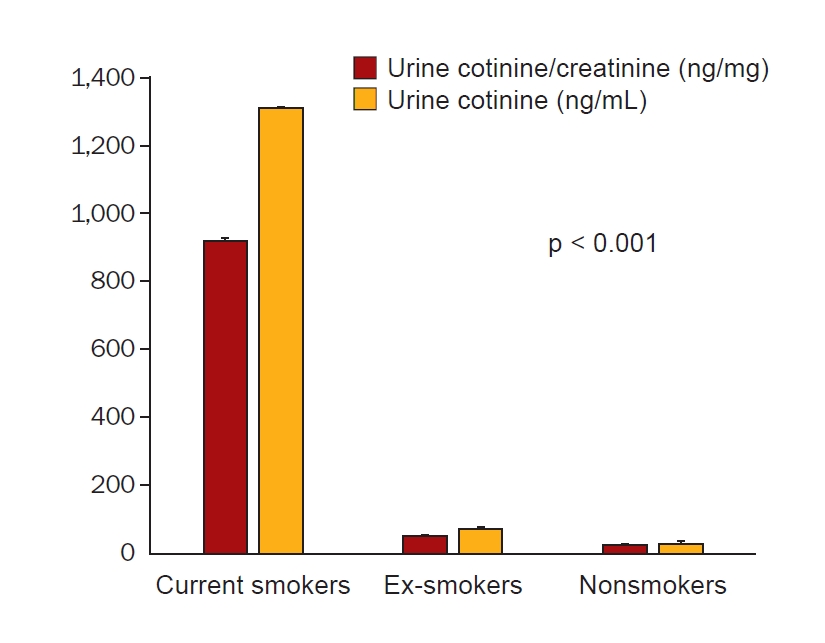
Background: Smoking and sodium intake (SI) have been evaluated as risk factors for kidney disease; however, the data are inconsistent. We assessed the association between SI and cotinine-verified smoking status and the risk of albuminuria. Methods: An observational study using the Korea National Health and Nutrition Examination Survey (2008–2011 and 2014–2018) was performed. We included 37,410 adults with an estimated... -
DOI: https://doi.org/10.23876/j.krcp.22.133 [Epub ahead of print]
- Clinical significance of the living kidney donor profile index for predicting long-term posttransplant outcomes: results from the Korean Organ Transplantation Registry
- Jong Ho Kim, Sang Ho Lee, Jin Sug Kim, Hyeon Seok Hwang, Hyunmin Ko, Cheol-Woong Jung, Deok Gie Kim, Yeong Hoon Kim, Jaeseok Yang, Curie Ahn, Kyung Hwan Jeong
- Received November 17, 2022 Accepted March 11, 2023
-

Background: The usefulness of the living kidney donor profile index (LKDPI) has not been widely demonstrated; therefore, it requires verification before clinical application. We analyzed the LKDPI using data from the Korean Organ Transplantation Registry (KOTRY) to confirm whether the LKDPI can be used to predict the survival of allografts in living donor kidney transplantation (LDKT) patients in Korea. Methods:... -
DOI: https://doi.org/10.23876/j.krcp.22.266 [Epub ahead of print]
- Examine the optimal multidisciplinary care teams for patients with chronic kidney disease from a nationwide cohort study
- Masanori Abe, Tsuguru Hatta, Yoshihiko Imamura, Tsutomu Sakurada, Shinya Kaname
- Received February 12, 2023 Accepted March 31, 2023
-
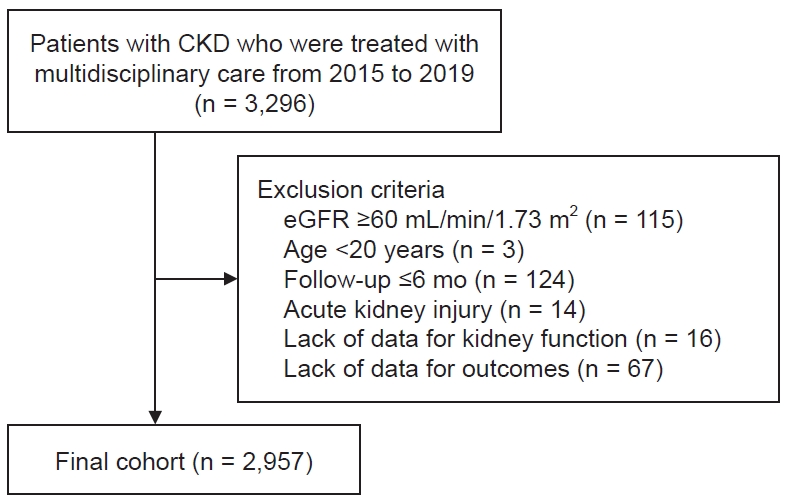
Background: Multidisciplinary team-based integrated care (MDC) has been recommended for patients with chronic kidney disease (CKD). However, team-based specific structured care systems are not yet established. Therefore, we investigated the efficacy of MDC system and the optimal number of professionals that make up the team for maintaining kidney function and improving prognosis. Methods: This nationwide, multicenter, observational study included 2,957... -
DOI: https://doi.org/10.23876/j.krcp.23.026 [Epub ahead of print]
- A comparative study of epidemiological characteristics, treatment outcomes, and mortality among patients undergoing hemodialysis by health insurance types: data from the Korean Renal Data System
- Kyeong Min Kim, Soyoung Lee, Jong Ho Shin, Mira Park
- Received September 29, 2022 Accepted May 11, 2023
-
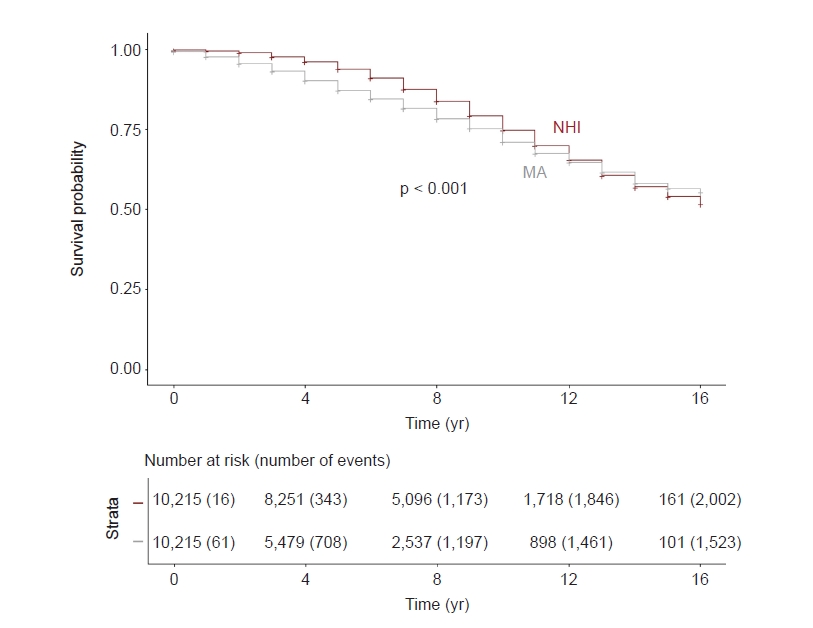
Background: The prevalence of end-stage renal disease (ESRD) requiring dialysis has progressively increased. Therefore, to achieve financial stability by managing the increasing numbers of patients undergoing hemodialysis (HD), a fixed-payment system was introduced in 2001 for medical aid (MA) beneficiaries receiving HD in Korea. Methods: We identified patients in the Korean Renal Data System that received HD between 2001 and 2017... -
DOI: https://doi.org/10.23876/j.krcp.22.220 [Epub ahead of print]
- Nephrology consultation improves the clinical outcomes of patients with acute kidney injury
- Harin Rhee, Meeyoung Park, Il Young Kim
- Received February 22, 2023 Accepted March 26, 2023
-

Background: Acute kidney injury (AKI) is prevalent in critically ill patients and is associated with an increased risk of in-hospital mortality. Nephrology consultation may be protective, but this has rarely been evaluated in South Korea. Methods: This multicenter retrospective study was based on the electronic medical records (EMRs) of two third-affiliated hospitals. We extracted the records of patients admitted to intensive... -
DOI: https://doi.org/10.23876/j.krcp.23.039 [Epub ahead of print]
- Effect of immunosuppressive agents on clinical outcomes in idiopathic membranous nephropathy
- Ji-Young Choi, Ho Jun Chin, Hajeong Lee, Yena Jeon, Jeong-Hoon Lim, Hee-Yeon Jung, Jang-Hee Cho, Chan-Duck Kim, Yong-Lim Kim, Sun-Hee Park
- Received November 3, 2022 Accepted February 25, 2023
-

Background: Few comparative studies on the effects of immunosuppressants in patients with idiopathic membranous nephropathy have been conducted. Methods: Data from 489 patients who received conservative treatment or immunosuppressants were retrospectively analyzed by propensity score matching. Primary outcomes were complete or partial remission (CR or PR) of proteinuria, and secondary outcomes were renal survival and infection. Results: Of the 489 patients,... -
DOI: https://doi.org/10.23876/j.krcp.22.255 [Epub ahead of print]
- Loss of Cutibacterium is responsible for chronic kidney disease-associated pruritus in patients on dialysis
- Jeong Geon Lee, Hoonhee Seo, Seung Seob Son, Hee Seul Jeong, Kyung Mi Lee, Nam-Jun Cho, Samel Park, Hyo-Wook Gil, Hyun-A Park, Sukyung Kim, Eun Young Lee
- Received March 9, 2023 Accepted May 4, 2023
-
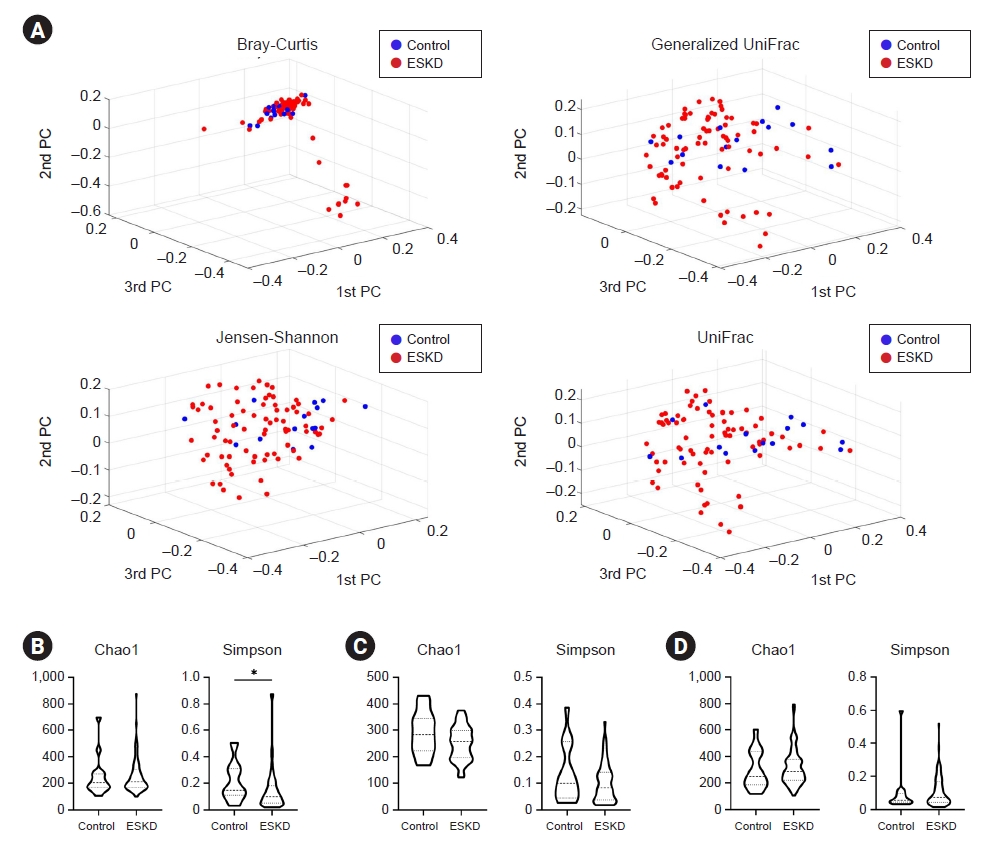
Background: Chronic kidney disease (CKD)-associated pruritus is a severe distressing condition that frequently occurs in patients undergoing dialysis. In this study, the profile of the skin microbiome was analyzed to understand the underlying etiology and potential treatments. Methods: Seventy-six end-stage kidney disease (ESKD) patients (hemodialysis, 40; peritoneal dialysis, 36) and 15 healthy controls were enrolled and swabbed at three sites:... -
DOI: https://doi.org/10.23876/j.krcp.23.057 [Epub ahead of print]
- Clinical relevance of blood urea nitrogen to serum albumin ratio for predicting bacteremia in very young children with febrile urinary tract infection
- Hyesun Hyun, Yeon hee Lee, Na Yoon Kang, Jin-Soon Suh
- Received December 15, 2022 Accepted May 7, 2023
-

Background: Urinary tract infections (UTIs) are one of the most common bacterial infections in febrile children and a common cause of hospitalization, especially in very young children. We examined the clinical characteristics and predictive factors of concomitant bacteremia in pediatric patients with febrile UTI aged ≤24 months. Methods: This retrospective multicenter study reviewed medical data from 2,141 patients from three centers... -
DOI: https://doi.org/10.23876/j.krcp.22.289 [Epub ahead of print]
- The impact of severe depression on the survival of older patients with end-stage kidney disease
- You Hyun Jeon, Jeong-Hoon Lim, Yena Jeon, Yu-Kyung Chung, Yon Su Kim, Shin-Wook Kang, Chul Woo Yang, Nam-Ho Kim, Hee-Yeon Jung, Ji-Young Choi, Sun-Hee Park, Chan-Duck Kim, Yong-Lim Kim, Jang-Hee Cho
- Received November 13, 2022 Accepted May 4, 2023
-
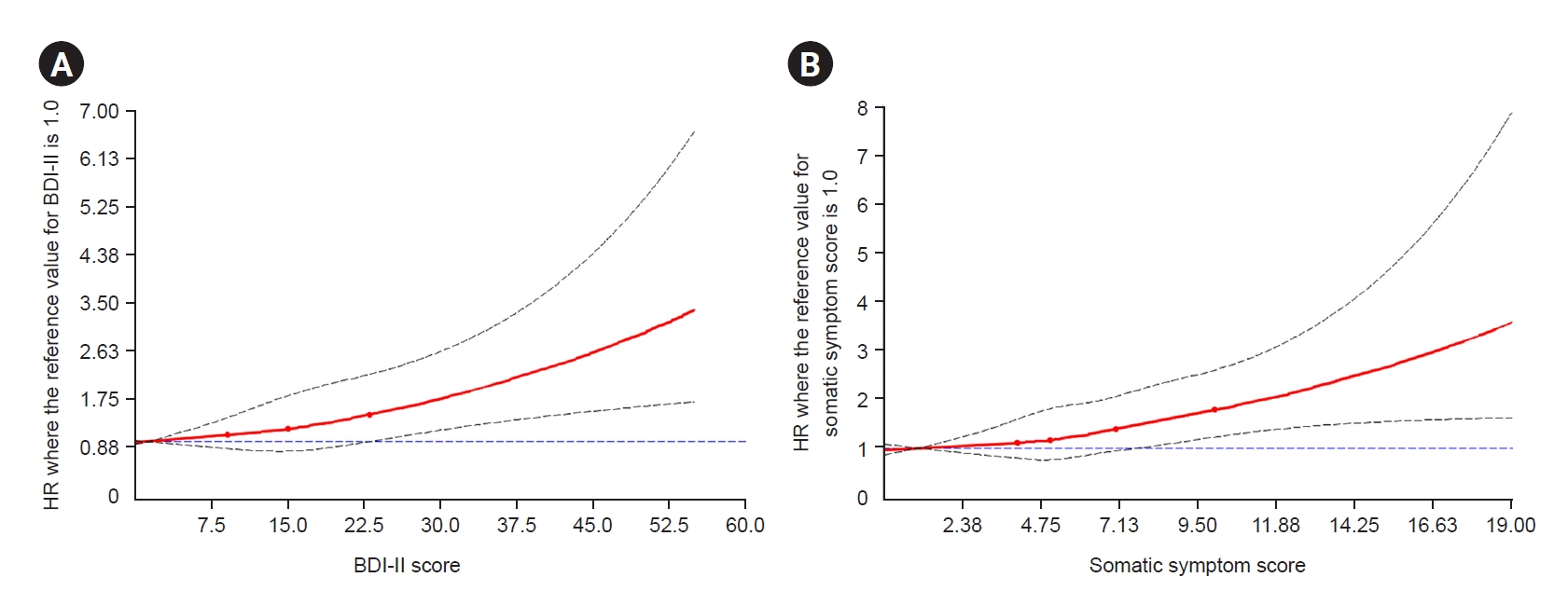
Background: Incidence of depression increases in patients with end-stage kidney disease (ESKD). We evaluated the association between depression and mortality among older patients with ESKD, which has not been studied previously. Methods: This nationwide prospective cohort study included 487 patients with ESKD aged >65 years, who were categorized into minimal, mild-to-moderate, and severe depression groups based on their Beck Depression Inventory-II... -
DOI: https://doi.org/10.23876/j.krcp.22.268 [Epub ahead of print]
- Indoxyl sulfate induces apoptotic cell death by inhibiting glycolysis in human astrocytes
- Seung-Hyun Jeong, Samel Park, Jae-sung Choi, Nam-Jun Cho, Jong-Seok Moon, Hyo-Wook Gil
- Received December 29, 2022 Accepted April 19, 2023
-
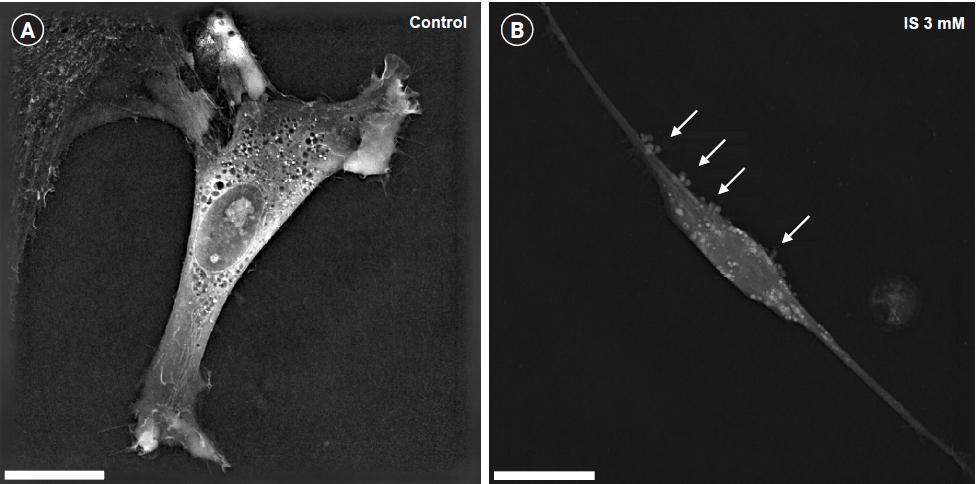
Background: Neurologic complications, such as cognitive and emotional dysfunction, have frequently been observed in chronic kidney disease (CKD) patients. Previous research shows that uremic toxins play a role in the pathogenesis of CKD-associated cognitive impairment. Since astrocytes contribute to the protection and survival of neurons, astrocyte function and brain metabolism may contribute to the pathogenesis of neurodegeneration. Indoxyl sulfate (IS)... -
DOI: https://doi.org/10.23876/j.krcp.23.005 [Epub ahead of print]
- Pan-Nox inhibitor treatment improves renal function in aging murine diabetic kidneys
- Jeong Hoon Park, Sung Gi Yoon, Jung Yeon Ghee, Ji Ae Yoo, Jin Joo Cha, Young Sun Kang, Sang Youb Han, Yun Jae Seol, Jee Young Han, Dae Ryong Cha
- Received January 4, 2023 Accepted April 22, 2023
-

Background: Aging is a risk factor for development of chronic kidney disease and diabetes mellitus with commonly shared features of chronic inflammation and increased oxidative stress. Here, we investigated the effect of pan-Nox-inhibitor, APX-115, on renal function in aging diabetic mice. Methods: Diabetes was induced by intraperitoneal injection of streptozotocin at 50 mg/kg/day for 5 days in 52-week-old C57BL/6J mice.... -
DOI: https://doi.org/10.23876/j.krcp.23.004 [Epub ahead of print]
- Intrinsic prefrontal functional connectivity according to cognitive impairment in patients with end-stage renal disease
- Kang Min Park, Chang Min Heo, Dong Ah Lee, Hyuk Huh, Sihyung Park, Yang Wook Kim, Yoo Jin Lee, Hyeok Jin Yoon, Bong Soo Park
- Received December 20, 2022 Accepted March 24, 2023
-

Background: This study aimed to investigate differences in intrinsic prefrontal functional connectivity according to the presence of cognitive impairment in patients with end-stage renal disease (ESRD) using functional near-infrared spectroscopy (fNIRS). Methods: We prospectively enrolled 37 patients with ESRD who had been undergoing hemodialysis for more than 6 months and had no history of neurological or psychiatric disorders. All patients... -
DOI: https://doi.org/10.23876/j.krcp.22.291 [Epub ahead of print]
- The feasibility of incremental peritoneal dialysis for older patients on peritoneal dialysis
- Ruihua Liu, Jing Guo, Hongjian Ye, Yuan Peng, Haishan Wu, Haiping Mao, Qunying Guo, Fengxian Huang, Xiao Yang
- Received September 2, 2022 Accepted April 3, 2023
-

Background: This study was performed to investigate the feasibility of incremental peritoneal dialysis (iPD) in older patients. Methods: In this retrospective cohort study, we enrolled peritoneal dialysis (PD) patients with age ≥ 60 years old at our center from 2008 to 2017. The patients were divided into two groups based on the daily PD exchanges: iPD group (≤3 × 2... -
DOI: https://doi.org/10.23876/j.krcp.22.202 [Epub ahead of print]
- Factors associated with gait speed: results from the RolE of AST120 (Renamezin) in sarCOpenia preVEntion in pRe-dialYsis chronic kidney disease patients (RECOVERY) study
- Miyeun Han, Sang Heon Song, Su Hyun Kim, Ran-hui Cha, Seock Hui Kang, Won Suk An, Jun Chul Kim
- Received July 6, 2022 Accepted December 25, 2022
-

Background: Gait speed is an important measure of functional ability. This study aimed to investigate the factors associated with gait speed in patients with chronic kidney disease. The study focused on sarcopenic components, plasma uremic or inflammatory marker levels, and quality of life effects. Methods: The RolE of AST120 (Renamezin) in sarCOpenia preVEntion in pRe-dialYsis chronic kidney disease patients is... -
DOI: https://doi.org/10.23876/j.krcp.22.143 [Epub ahead of print]
- Vitamin D and narrowband ultraviolet B phototherapy for chronic kidney disease-associated pruritus
- Youn Kyung Kee, Hee Jung Jeon, Jieun Oh, Dong Ho Shin
- Kidney Res Clin Pract. 2024;43(2):177-185. Published online March 22, 2023
-

Background: In addition to improving the serum vitamin D balance, narrowband ultraviolet B (NB-UVB) phototherapy can effectively treat chronic kidney disease-associated pruritus (CKD-aP). We investigated the degree of CKD-aP amelioration according to changes in the serum vitamin D level after NB-UVB phototherapy. Methods: This was a before–after clinical study in patients with refractory CKD-aP on hemodialysis. NB-UVB phototherapy was administered... -
DOI: https://doi.org/10.23876/j.krcp.22.153 [Epub ahead of print]



